As the only bit of apparel that's with you for every step of your race, the tri-suit (also called a triathlon suit) is a fundamental piece of triathlon gear. Here’s our guide to the best tri-suits on the market, whether you're racing sprint or Ironman, on a budget or looking for aerodynamic gains.
What is a tri-suit?
A tri-suit (or triathlon suit) is a garment specifically designed for racing all three disciplines of triathlon. Made of a similar quick-drying fabric to swimwear, it's flexible, hydrodynamic and aerodynamic so it can cater for the demands of swimming, cycling and running.
It includes a pad/chamois for comfort on the bike leg, but this pad shouldn't obstruct your final run leg.
For a more detailed explanation, see our article: What is a tri-suit?
How we tested these tri-suits
The triathlon suits here were all given multiple tests on the swim, bike and run to find the best one. Key factors included breathability, how fast they dried, chafing (or lack of), pocket sizing and accessibility, and the effectiveness of the leg grippers and zippers.
The pad was assessed for how quickly it dried after the swim, its ability to provide comfort on the bike leg and whether the size impacted on the run.
The price, aesthetics, durability and aerodynamics were also considered, as was the versatility of each suit. Many of the Ironman tri-suits were also tested for their aerodynamic abilities at the Silverstone Sports Engineering Hub's wind tunnel.
Tried and tested: The best tri-suits at a glance
- Best budget tri-suit: Dhb Aeron Sleeveless | Buy now from Wiggle
- Best tri-suit for Ironman: Zone3 Lava Long Distance | Buy now from Wiggle
- Best all-rounder for men: Tri-Fit Evo Next Gen | Buy now from Tri-Fit
- Best all-rounder for women: Trimtex Aero 3.0 | Buy now from Trimtex
Jump to:
Best short-sleeved tri-suits
Elbow-length suits are equipped for the needs of the modern-day triathlete: shoulders and sleeves help to protect your skin; improved pads aid comfort; and fabrics are designed to be both hydro- and aerodynamic.
On top of all that, manufacturers have thought about the practicalities of getting them on and off and have started getting creative with their designs, producing tri-suits for a variety of distances. Time, then, to take a look at some of the best triathlon short-sleeved tri-suits on the market...
Best short-sleeved tri-suits for men
Zone3 Aeroforce X II
- Buy now from Wetsuit Centre (£298.95)
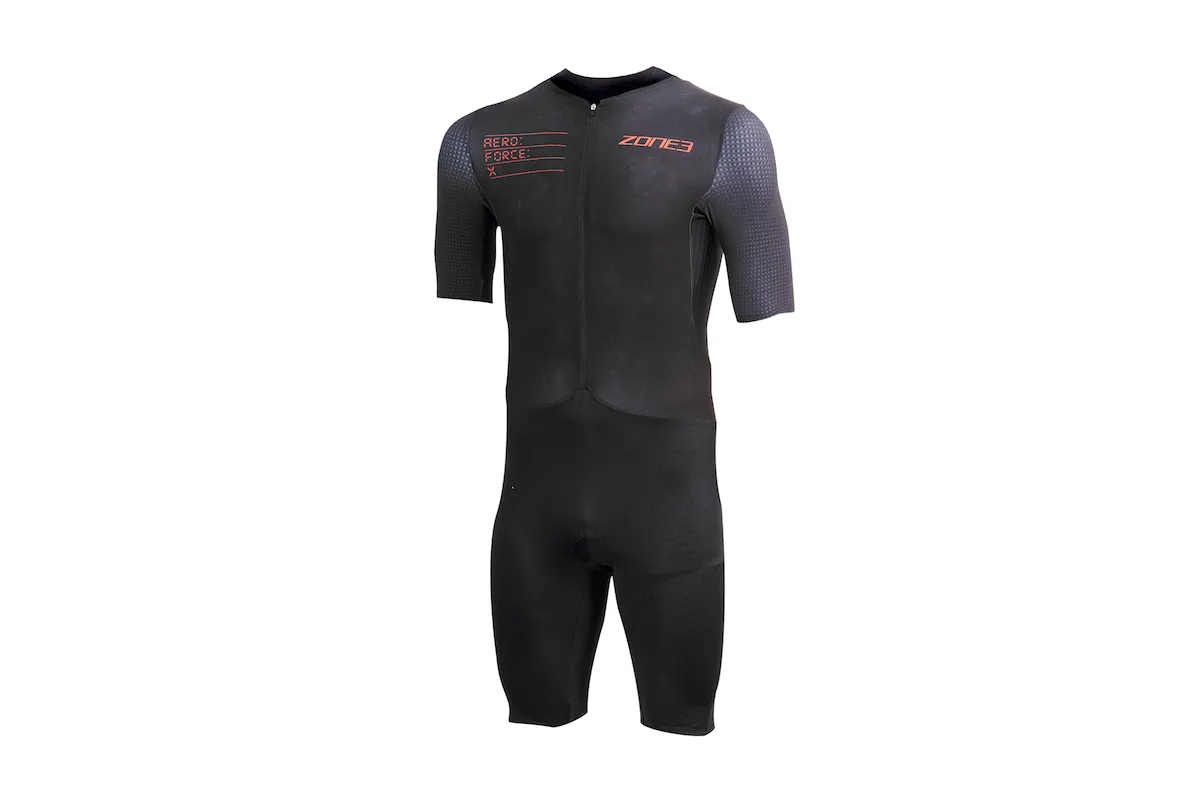
- £380 / $430
This new launch from Zone3 comes with futuristic graphics to match the tech used in its construction.
A lot of aero development has gone into this suit and it shows, with dimpled sleeves, a textured fabric on the legs and the brand's Aero Soft-Touch material on the front.
It cuts through the water well, too, with noticeably beading up on the fabric's surface.
We weren't such a big fan of the lack of cutaway zip, which makes toilet breaks a trickier affair, while the zip guard also wasn't quite as comfortable or effective as we'd like.
This mid-pack tester found the chamois too minimal for long-course racing, but elsewhere we were a fan of the flexibility on offer.
Read our full Zone3 Aeroforce X II review for more.
Verdict: We'd recommend this aerodynamic suit for Olympic-distance and no longer than 70.3 racing.
Score: 85%
Castelli PR 2 Speed Suit
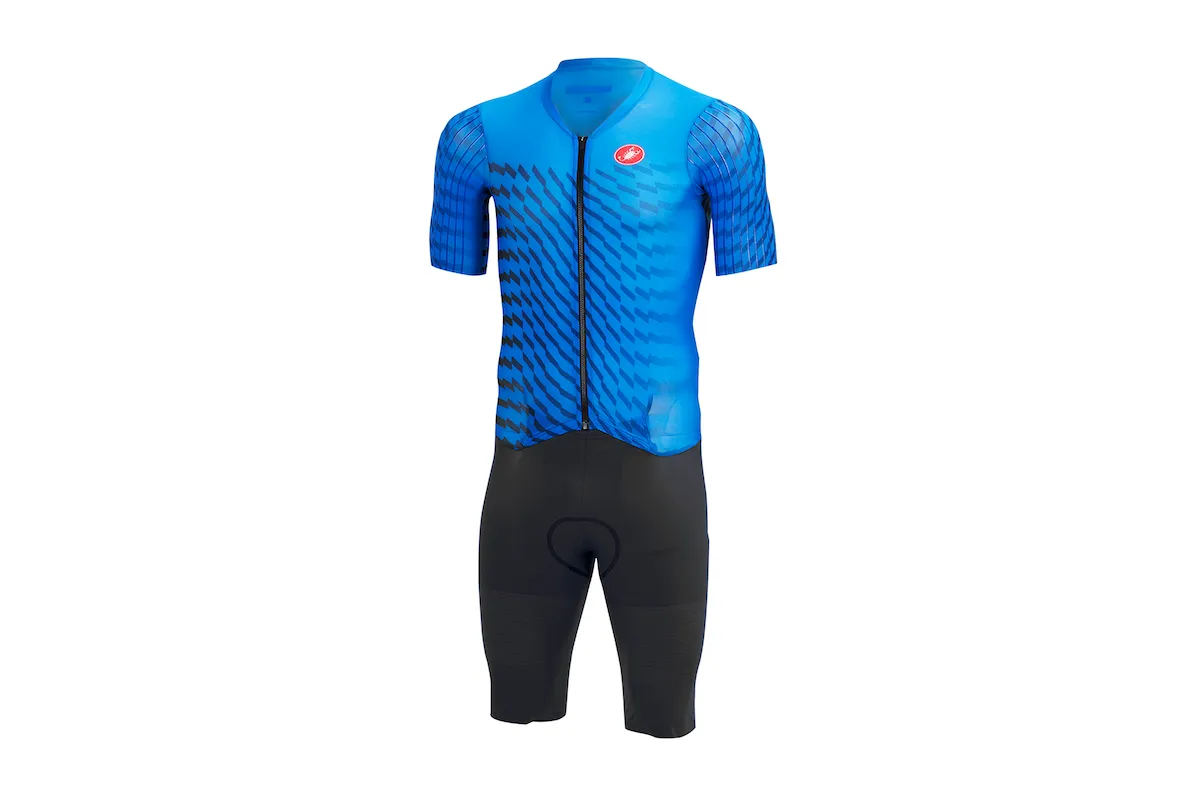
- £350 / $389.99
Castelli’s original PR was a techy wonder that saw Aussie Cam Wurf break the Kona bike course record in it, and the Italians haven’t strayed far from the original’s template.
The lithe but effective laser-cut legs and arms, supportive pad and ribbed aero sleeves are all present and correct, as are the sizeable but swim-friendly duo of rear pockets.
We much prefer this new blue version over the see-through orange of V1, and again it sits on the body like a second skin without being restrictive on the swim, bike or run, while staying wrinkle-free.
Admittedly, it does feel very delicate, so we’d treat it nicely, save it for race day and avoid any off-road excursions where beastly thorns may lurk.
There has, however, been a £50 rise in price, making this one of the most expensive tri-suits ever produced.
Verdict: A techy, speedy and supple wonder... if you can afford it.
Score: 87%
Orca Apex Dream Kona
- Buy now from TradeInn (£197.99)
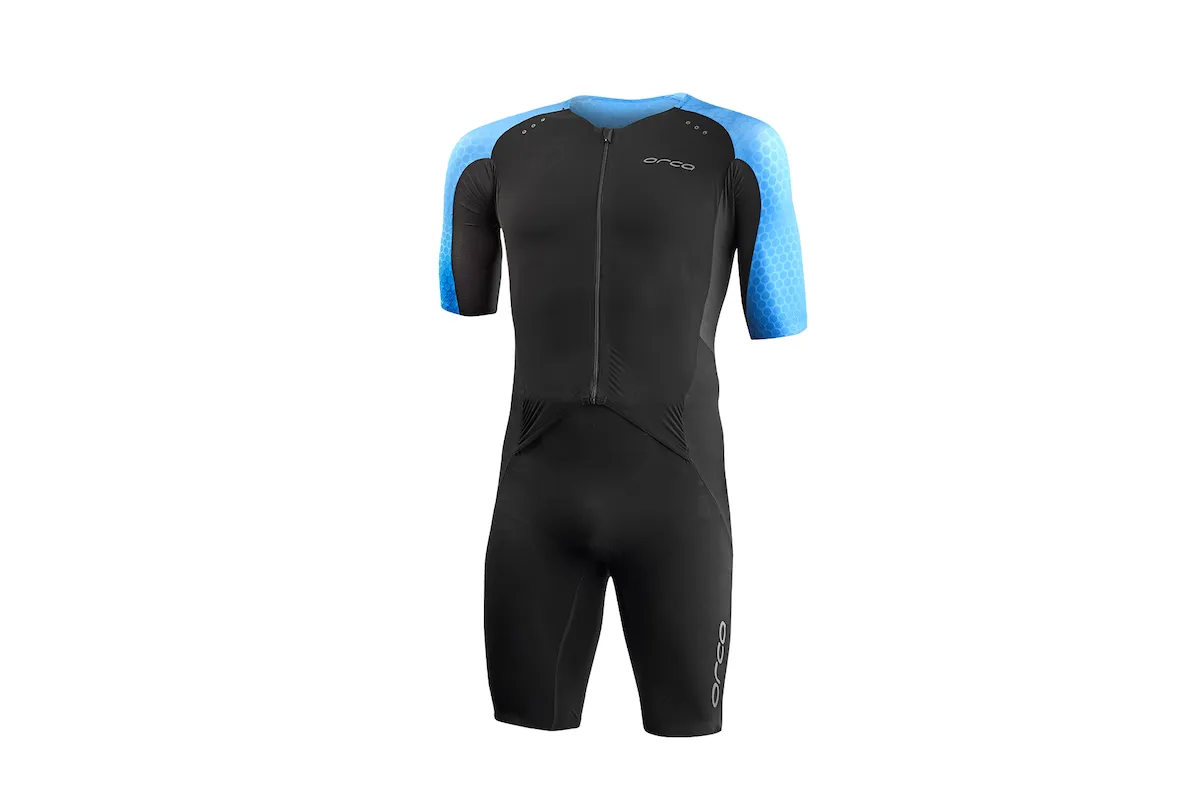
- £279.99 / $349
The Apex is a sequel to Orca’s RS1, and the brand has again thrown all its aero bells and whistles at this new suit.
The hydrophobic, water-beading fabric would be our pick here for any pool or non-wetsuit swims, while the textured tunnel-tested materials and streamlined fit (go up if you’re between sizes) highlight the drag-reducing prowess.
It’s lean and lightweight, the full-length zipper is great, but there’s also the matter of a scratchy zipper head and the upper leg fabric bunching a little at the very top of the thigh.
Maybe the elite racers who devised the suit have tougher bottoms than us, but we’d personally go no further than Olympic-distance tri in the Apex due to the barely-there pad.
For a short-course, non-wetsuit blast, however, we can think of few suits more slippery.
Verdict: Superb for shorter races, but we'd question that Kona billing.
Score: 83%
Orca Athlex Aero Race Suit
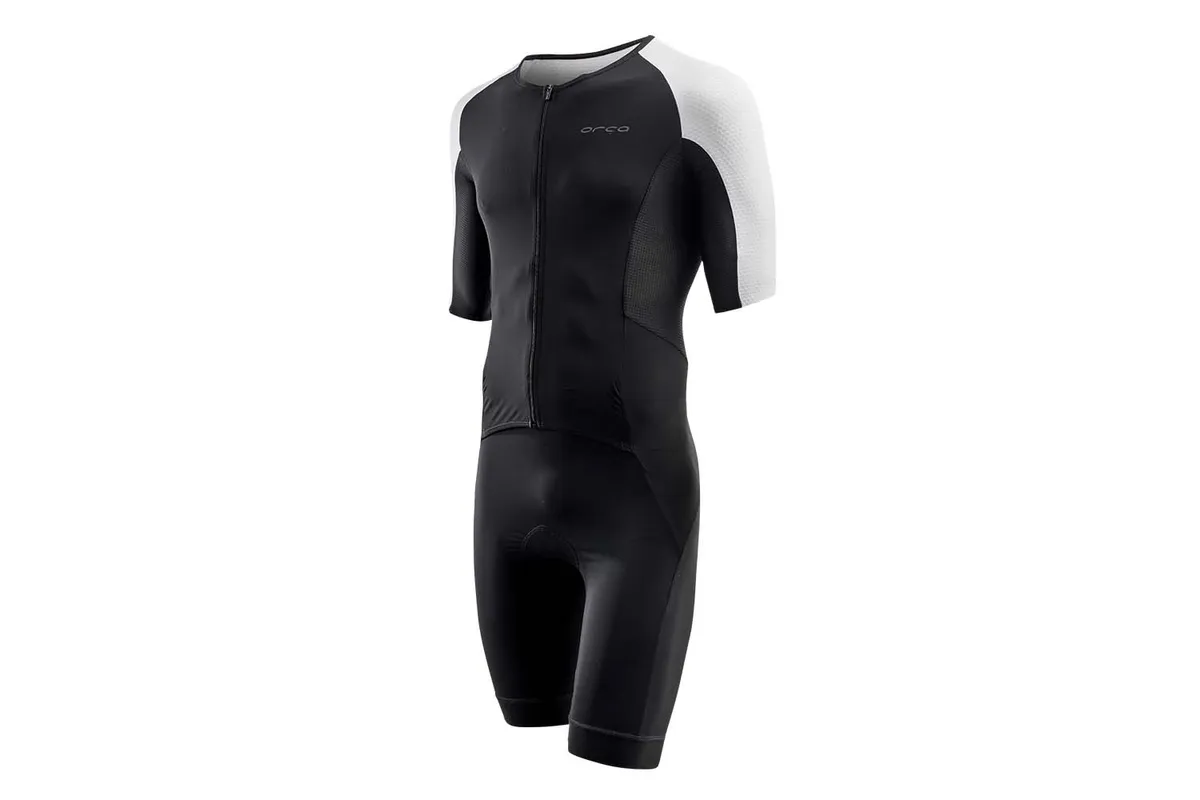
- £149 / $199
We don’t look at the price tags of these suits until after the testing has finished and I figured the dimpled fabrics, superior meshing and breathability of the new Athlex would put it above the £200 barrier.
Happily, it’s well below that. The cooling material composition and sizeable white back panel also lends this one to warmer racing climes.
Those aero dimpled sleeves are the business, while the pad is supportive yet supple on the bike and run, respectfully. The covered rear pockets and stretchy material make this the one for non-wetsuit swims, although the swallow depth of the two rear pockets means that taller gels can dislodge.
Points are also lost for lack of a zipper garage and the relatively basic leg grippers tend to move up and down the legs when cycling, though this is a mild irritation rather than a full-blown catastrophe.
Verdict: A brilliant suit that's speedy yet supportive and is a good choice.
Score: 83%
Tri-Fit Evo Next Gen
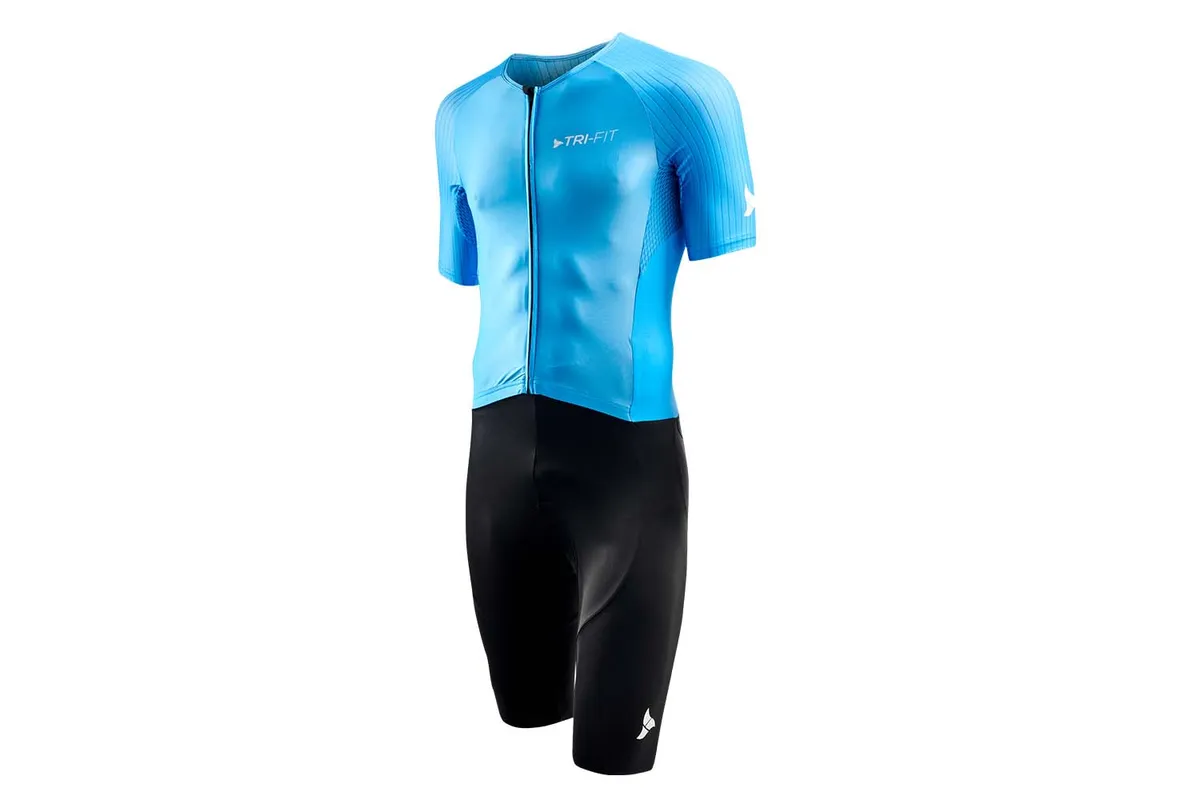
- £195 / $248
Tri-Fit’s debut Evo suit was just a couple of tweaks away from near maximum marks when we tested it in 2019 and the acclaim keeps flowing with the Evo Next Gen in 2022.
The suit builds on what made the Evo so good, the combo of Italian and German fabrics providing a silky-smooth internal experience and aerodynamic ribbed outer, with smartly-placed underarm mesh vents and superior leg grippers, adding to the winning composition.
The Next Gen again utilises the floating back pocket trick, which stops the pockets pulling on the suit when loaded, and yet there are swim benefits thanks to the side entry points.
That said, stuffing gels into the stealthy hip pockets in T1 at speed is tricky. The pad is a reliable one and the finishing quality has been improved, but some might want more padding for Ironman. It features a great full-length zipper and garage, though.
Verdict: A classy contender with silky-smooth fabrics and well-crafted tri flourishes.
Score: 91%
Nopinz Pro-1 Trisuit
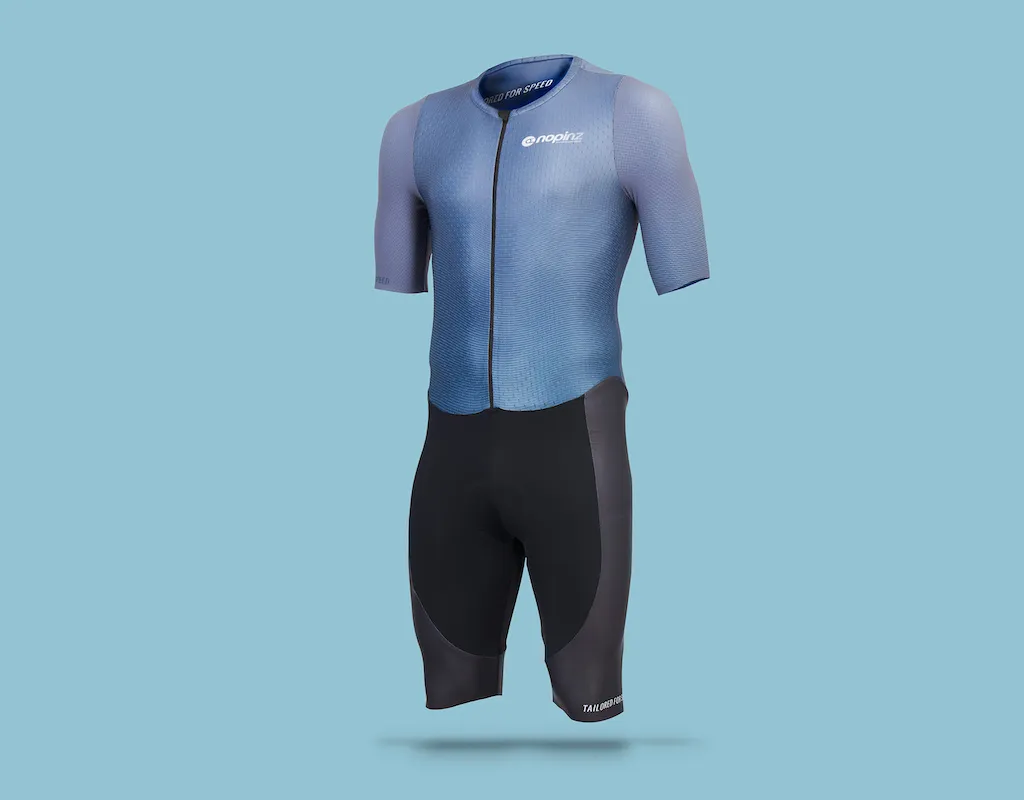
- £174.99 (UK only)
Devon's Nopinz has long been a force in the world of time-trial racing, but the brand’s tri presence has been more disguised, its most visible multisport output being the collaboration with Zone3 on the celebrated Aeroforce-X range from 2020.
Now the speed specialists have gone their own way with the new Pro-1 Trisuit... and it’s a humdinger.
Nopinz’s aero forte shines in the lengthy leg and arm sleeves, the latter complete with dimpled textures, all held secure with elasticated grippers.
While our limbs won’t be giving The Rock sleepless nights, the arms did admittedly feel a little tight here.
The upshot is the Pro-1 is wonderful in the water on non-wetsuit swims, adding hydrodynamics to its aerodynamic appeal.
The Kangaroo-style rear pocket also remained drag-free in the pool, while sizeable enough to stash a handful of gels on the bike.
The Fonte chamois is new to this tester and, while its classily stitched and smooth, we’d personally want more padding for anything over 90km.
The zipper garage is pretty minimal as well, and we felt a little irritation here, but the perforated material itself proved comfortable, breathable and quick to dry in September’s heatwave.
The Pro-1’s price of £175 undercuts its top-end rivals, including Zone3’s Aeroforce-X II (£300) and Huub’s Anemoi 2 (£300).
You’re essentially getting a semi-custom suit, too, with Nopinz making all of them in Devon and offering an array of sizes (2XS – 2XL) plus standard and tall options, too.
Nopinz’s tri presence won’t remain disguised for long with a suit of this calibre.
Verdict: A well-priced, comfy and aero suit in multiple sizing options.
Score: 91%
BornBound Skarvatten Long Distance Suit
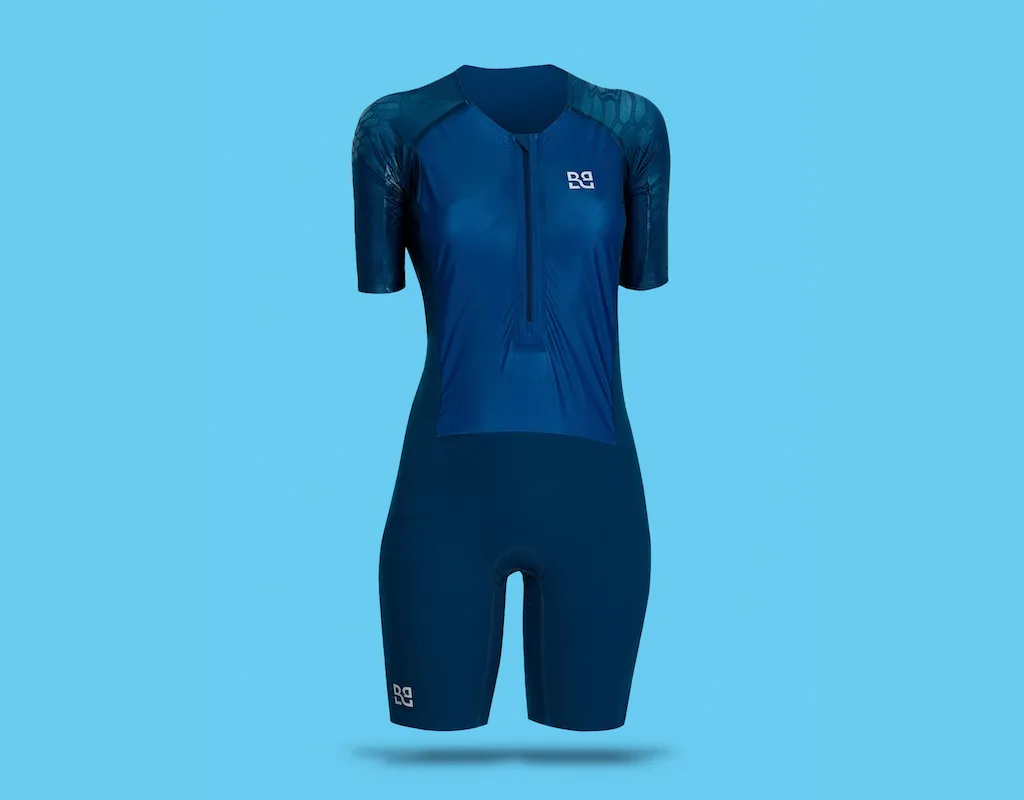
- £295 / $346
BornBound's ethos is to make high-performing tri kit using sustainable and ecologically sound methods.
The brand’s debut tri-suit doesn’t disappoint, with fast-drying fabric, smooth seams and flexible shoulders.
There’s also Cold Black fabrics and UPF 50 shoulder panels, which were welcome in the recent heatwave.
The compressive lower body delivered notable postural improvement on the swim and run, and while some may find this constrictive on the bike, sizing up should resolve this issue.
A well-padded chamois offered good cushioning, but while the narrow design meant it was unobtrusive on the run we did get a bit of chafing in the leg crease using a wide-nosed saddle over a longer distance.
Finally, two, easy-to-access rear pockets provided storage for several gels each.
Verdict: A stylish debut to the market providing an impressive postural boost.
Score: 87%
Aptonia Short-Distance Tri-suit
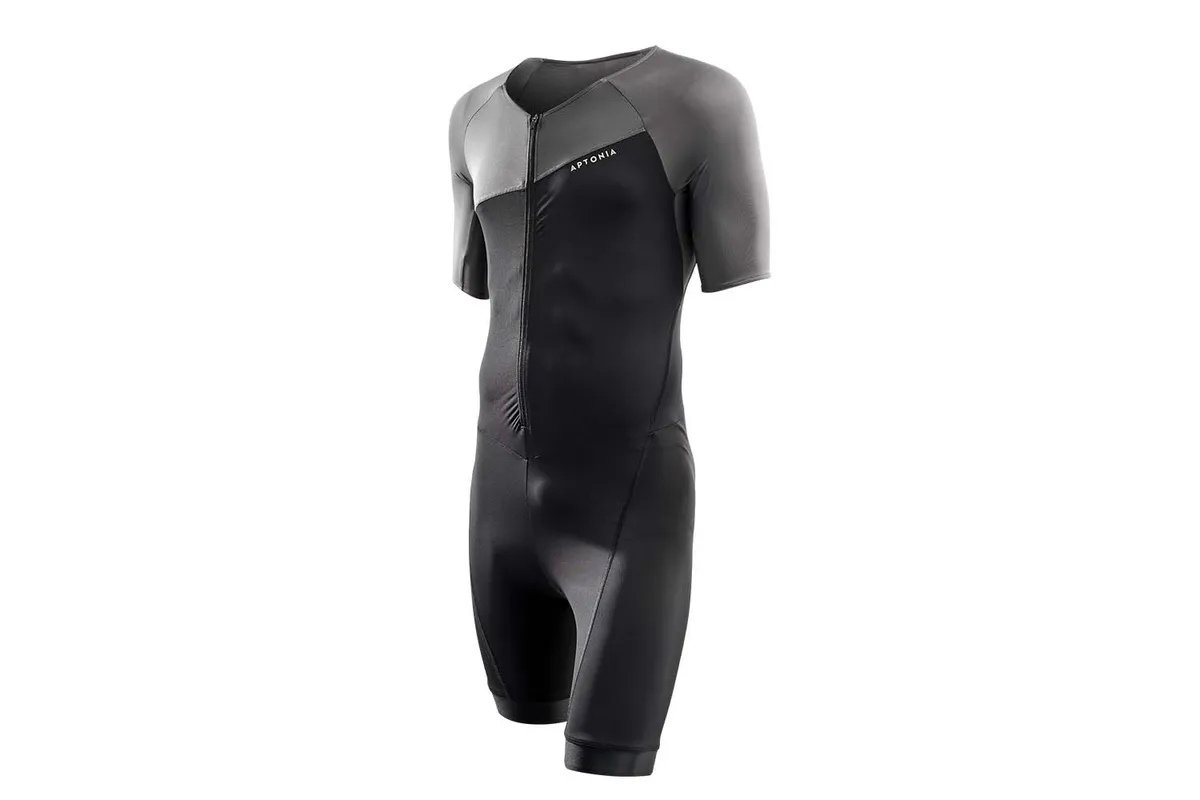
Decathlon’s in-house brands largely score well on these pages for their functional design and affordability, yet Aptonia’s trisuits haven’t yet answered the demands of triathlon racing.
Until now, with the new Short-Distance Trisuit. Neat triathlon touches abound, with a mesh strip along the spine for ventilation, leg pockets for gels, a full-length zip guard and a covered rear pocket for swim gains.
We even felt some compressive properties in the thighs. Of course, there are compromises. We’d prefer more than the single back pocket, the material composition and design can’t compete with Santini et al, and the elastic grippers are pretty limited.
The legs come up quite short as well. Given their quality bike kit, we’d like to see what Decathlon’s Van Rysel brand could do with twice this budget, but this is still a strong beginner suit with a welcome price.
Verdict: A few compromises, but we'd recommend this as a debut tri-suit for beginners.
Score: 80%
Santini Aahonoui Viper
- Buy now from Santini (£279)
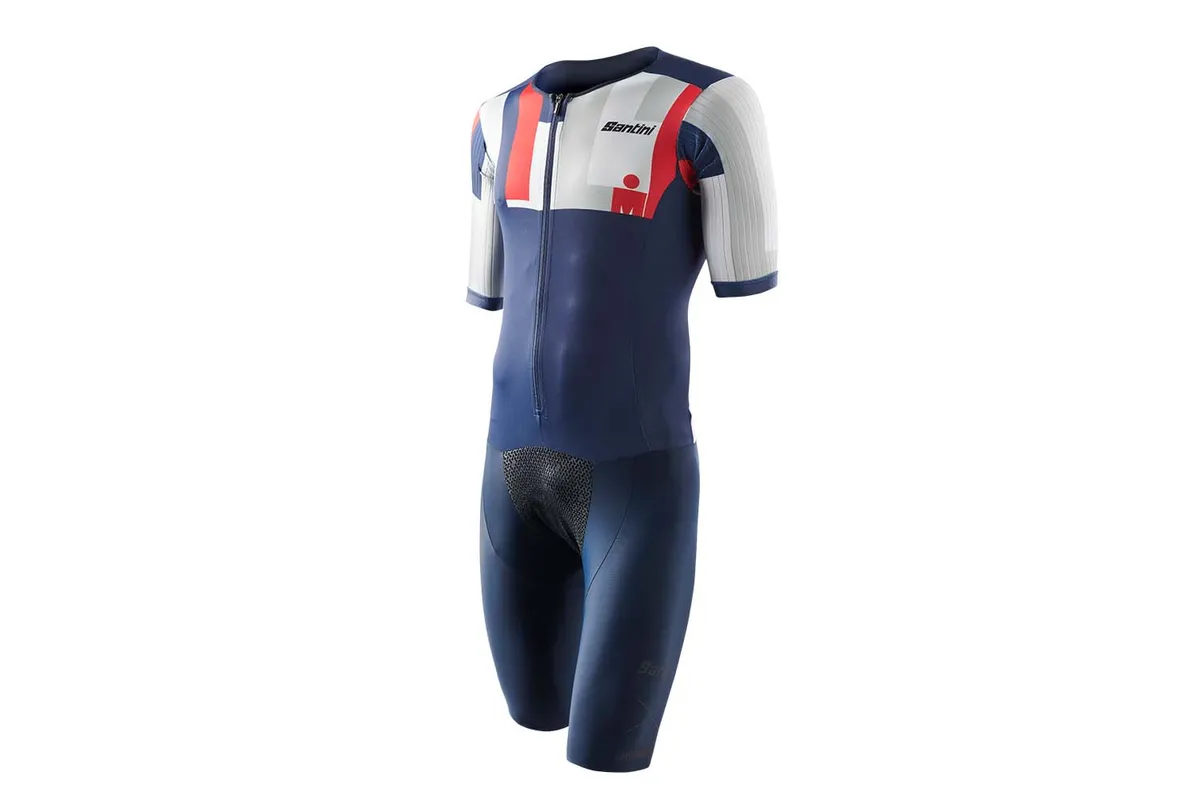
- €279
This Ironman collaboration from top-end Italian brand Santini instantly shows its class, with silky smooth materials and lengthy ribbed sleeves aimed at increasing the aerodynamic prowess.
So far, so expected. It continues to impress in the innovative details, the best being a grippy exterior that runs on the outside of the high-quality and supportive pad to prevent saddle slippage after the swim.
And yet it’s not all good. The lack of a breakaway zipper is an oddity on a suit with Ironman racing intentions in 2022, and the irritable inside of the zipper also tends to graze the skin on the bike and run.
The duo of rear pockets is also a little shallow for securely holding taller energy gels and the leg grippers, although seriously effective, may be a little too tight for those with stockier legs. Stylish design, however.
Verdict: Sleek and stylish, but zipper troubles and a worry and rear pockets are a little shallow.
Score: 80%
Zoot Elite Triathlon Aero Racesuit
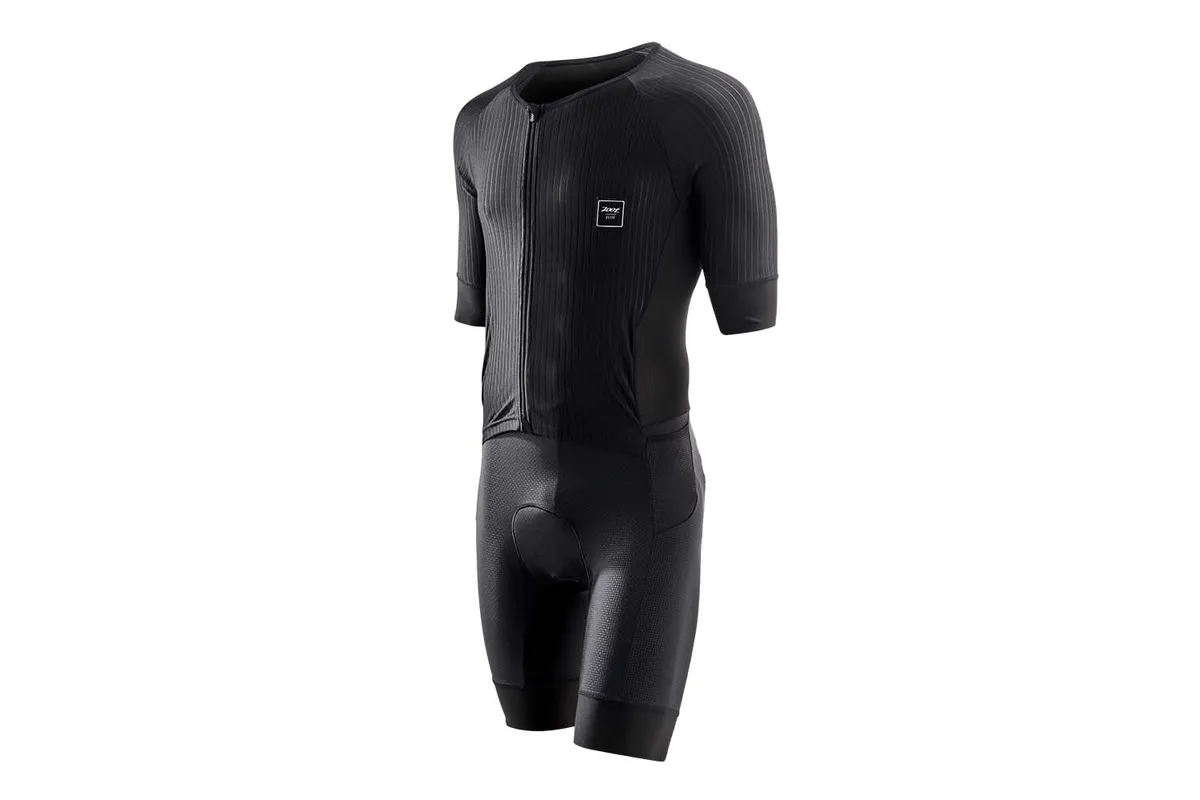
- £226 / $295
Zoot’s famously bold designs are missing from this sleek pinstripe suit and we miss them. Luckily the Elite has a trick or two up its aero sleeves, with a full-length zipper for speedy toilet stops, Zoot’s reliably smooth Italian fabrics and a sizeable mesh back for warmer climes.
There’s plenty of ribbed ‘Highway Aero’ fabric targeted at maximising any drag reduction, although we haven’t seen any wind tunnel or CfD data and we couldn’t detect recovery gains from the touted compressive fabric.
Those who prefer a plumper pad and are racing longer than Olympic distance may well want a beefier chamois, although the positive is that it’s near invisible on the run.
We’d prefer flatlock internal seams and more than one rear pocket. For all its class, the Elite struggles to justify its price tag.
Verdict: Classy fabrics but there are more versatile and better value suits here.
Score: 76%
Tri-Fit Evo 2.3
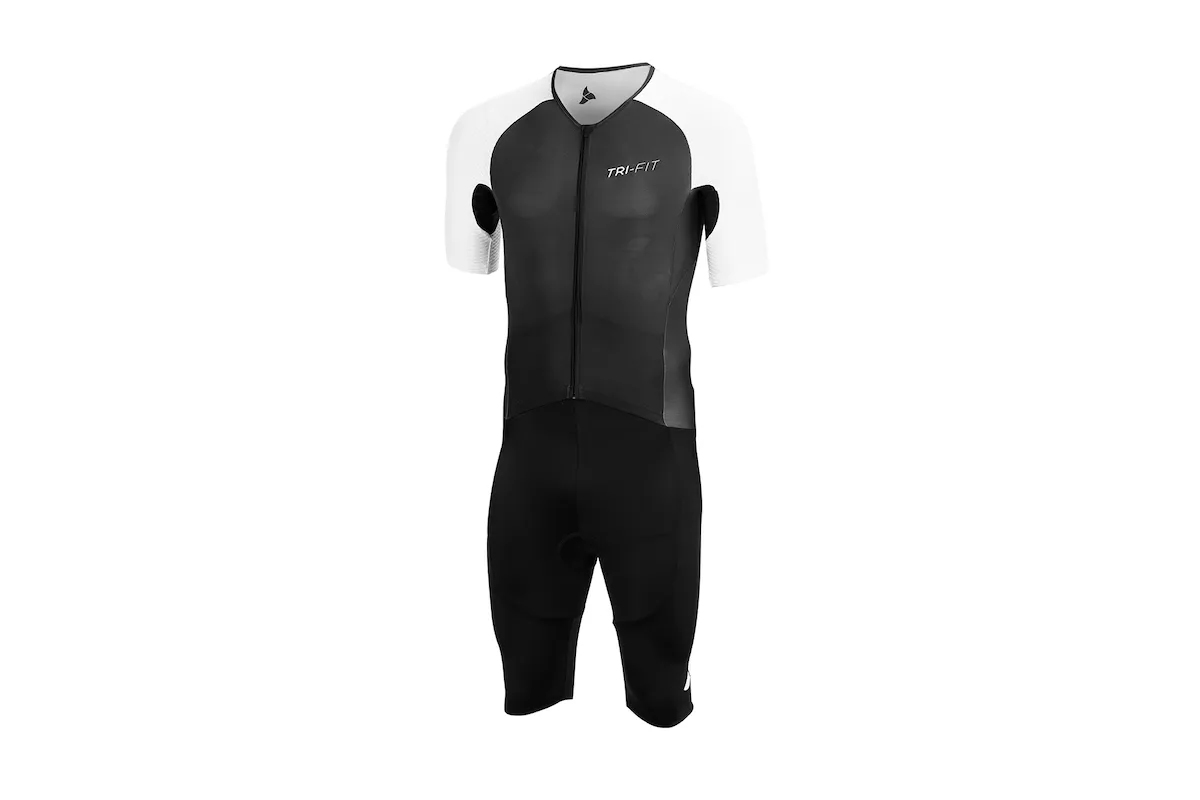
- £235 / $299
Multiple incarnations of Tri-Fit’s Evo have swiftly racked up plenty of 220 award badges in the past five years. Perhaps understandably, the brand takes an ‘if it ain’t broke’ approach with the Evo 2.3.
The smooth Italian materials, wind-tunnel tested fabrics, understated looks and side-entry rear pockets are all present and correct, although it’s not the easiest removing larger gels from the latter.
In terms of upgrades, the leg pockets are no more, the pinstripes on the sleeves have been replaced by dimples, while the leg grippers are now some of the most quietly effective you’ll ever find.
Less positively, the Elastic Interface pad has pretty limited padding for going long, there’s a slightly scratchy zipper head and minimal guard that bugged me on the run, and the crotch area leaves little to the imagination.
Verdict: More evolution than revolution, but still a silky and swift contender.
Score: 83%
Stolen Goat Remix
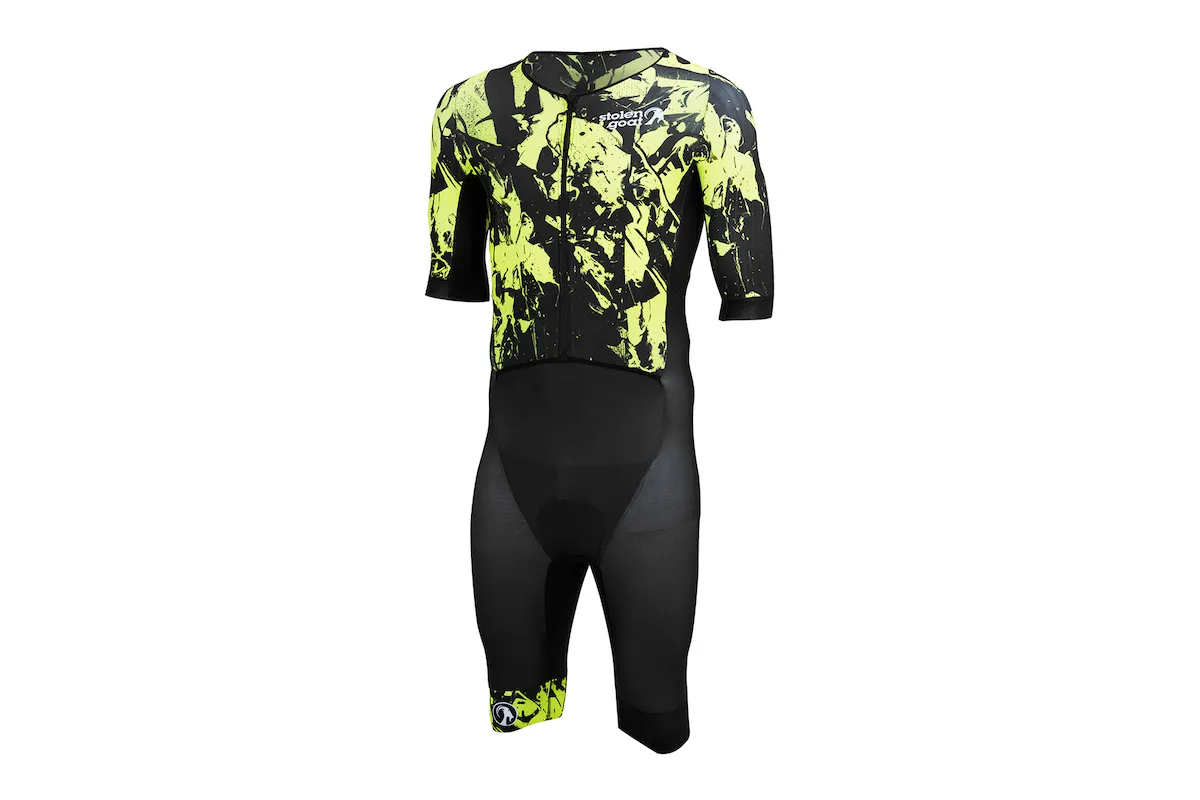
- £160 / $210
As we’ve come to expect from Stolen Goat, this tri-suit will make you visible on course with its splattered paint design on the front and rear.
The pattern is also evident on the effective leg grippers and pinstripe sleeves – a nod to aerodynamics (saving you 8-10 watts per sleeve, says SG) – and the deep and accessible pair of rear pockets.
Stolen Goat doesn’t target this at any specific race distance, but we’d go no longer than Olympic due to the slender pad – while it’s invisible on the run, we’d want more under our bottom for 70.3 and longer.
There’s a nice array of sizes, a full-length zipper garage and a lifetime guarantee, but we found the fit less than flattering due to the high-cut frontal area.
The result left this tester’s paunch on display below the zip, which is less than ideal given the attention-seeking graphics.
Verdict: Decent enough for short-course tri, but pad and paunch concerns.
Score: 72%
Best short-sleeved tri-suits for women
Assos Triator SS Speedsuit
- Buy now from AlpineTrek (£253.47)
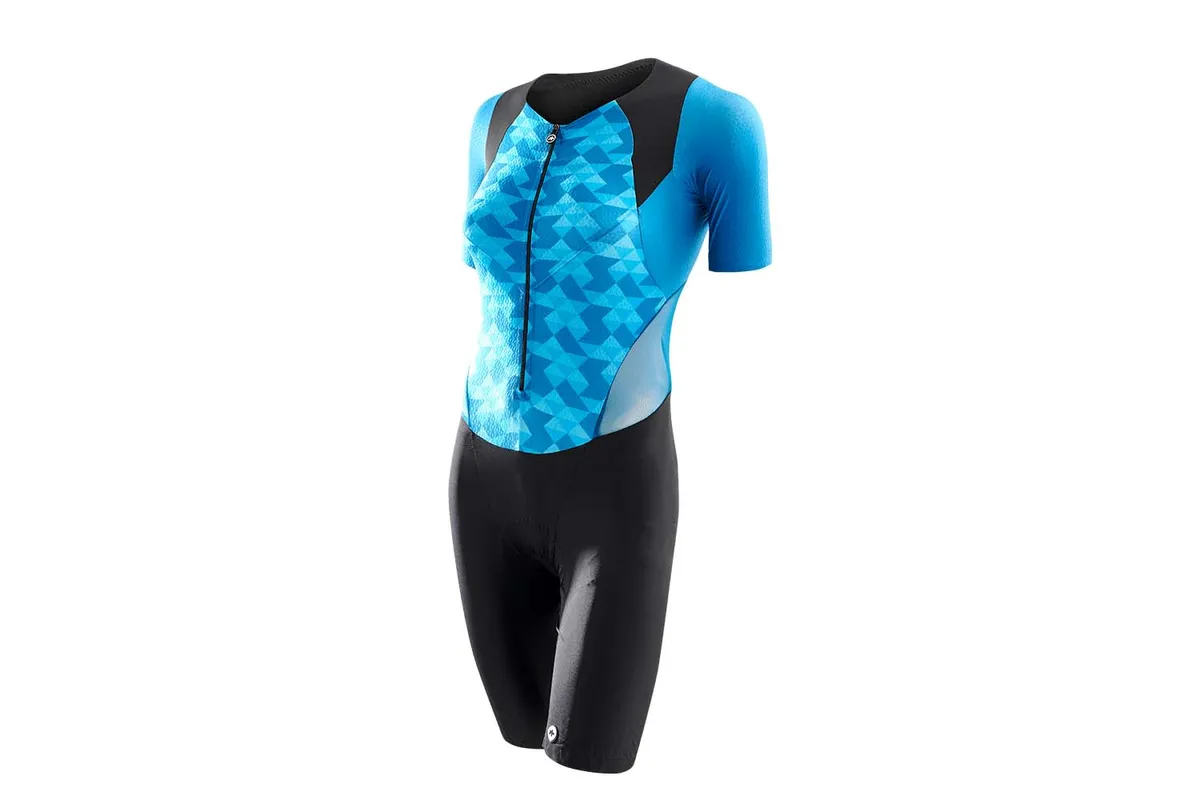
- £390 / $525
Swiss cycling brand Assos has made a bold debut into the premium tri market with the attractive Triator Speedsuit.
It’s clear from the chamois that this is a suit designed by people who spend time on bikes, offering a perfect blend of comfort and minimalism for long-distance racing.
The suit itself feels like a second skin, with honeycomb textured arms for enhanced aerodynamics and a scooped neckline which offers zero restriction.
Our only gripe’s the shoulders being set a little too narrow, which caused some tightness on the swim. The ultralight material dries exceptionally fast, with vented sides aiding heat dissipation and a special ice pocket in the neck for cooling during hot racing.
We like the graduated leg compression, offering all day support, and in addition to two rear pockets, the suit has two small pockets hidden inside the front.
Verdict: This suit oozes quality, a real luxury item for those who can afford it.
Score: 87%
Castelli PR Speed Tri Suit
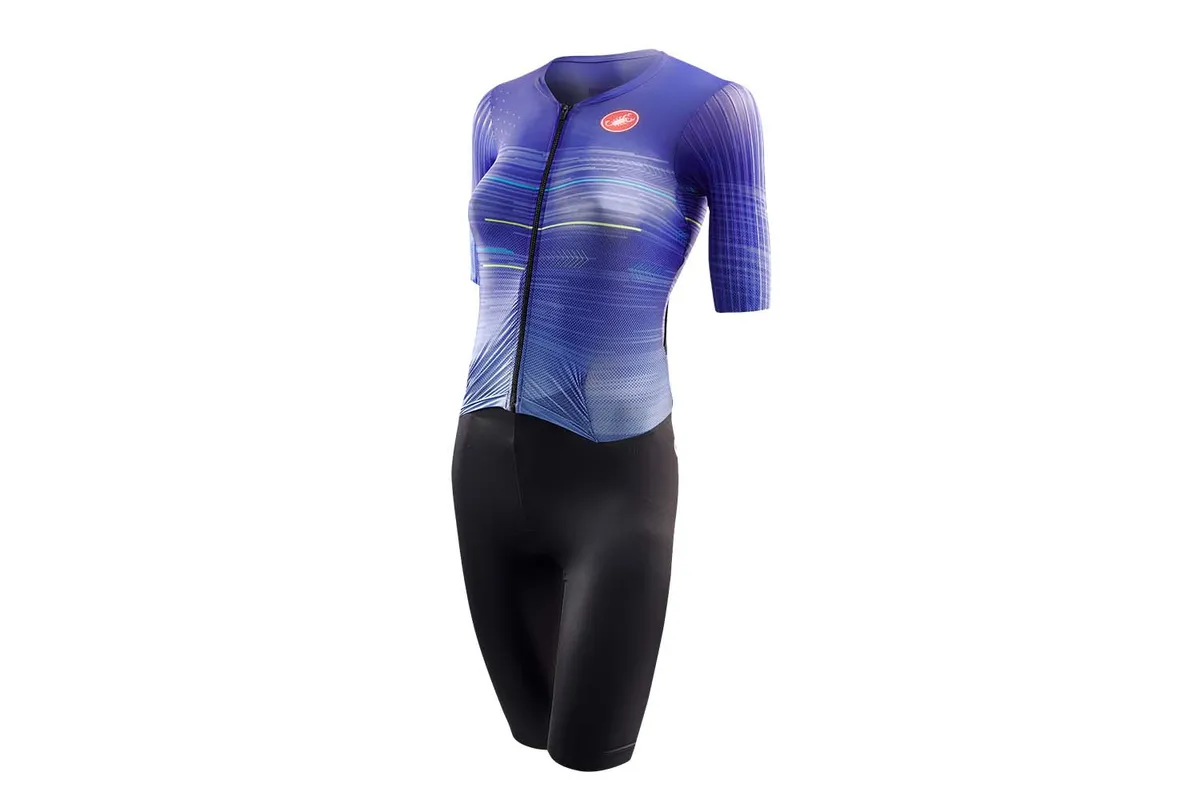
- £300 / $349.99
Castelli’s gone all in on aerodynamics, so much so the PR Speed would be illegal in a cycling event. In practice, this means the wind-tunnel-tested design has elbow-length striped silicone arms which aim to reduce drag on the bike.
Ultra-thin 50 denier fabric on the upper body means the fabric is quite literally barely there. This gives maximum cooling, but we’d question its sun protection capabilities.
Despite offering great shoulder flexibility, the upper body is on the small side, with the neck pulling us down when standing and the jersey-style top spontaneously unzipping on occasions when the zip’s nudged.
The chamois is also minimalist in design, but it still provided comfort and support in testing. Though not marketed as such, the legs feel compressive and supportive even on tired legs, and the dual rear pockets provide plenty of room for several gels or bars.
Verdict: A tri-suit for serious racing, with a luxurious feel and ample storage.
Score: 84%
Huub Her Spirit Long Course Tri Suit
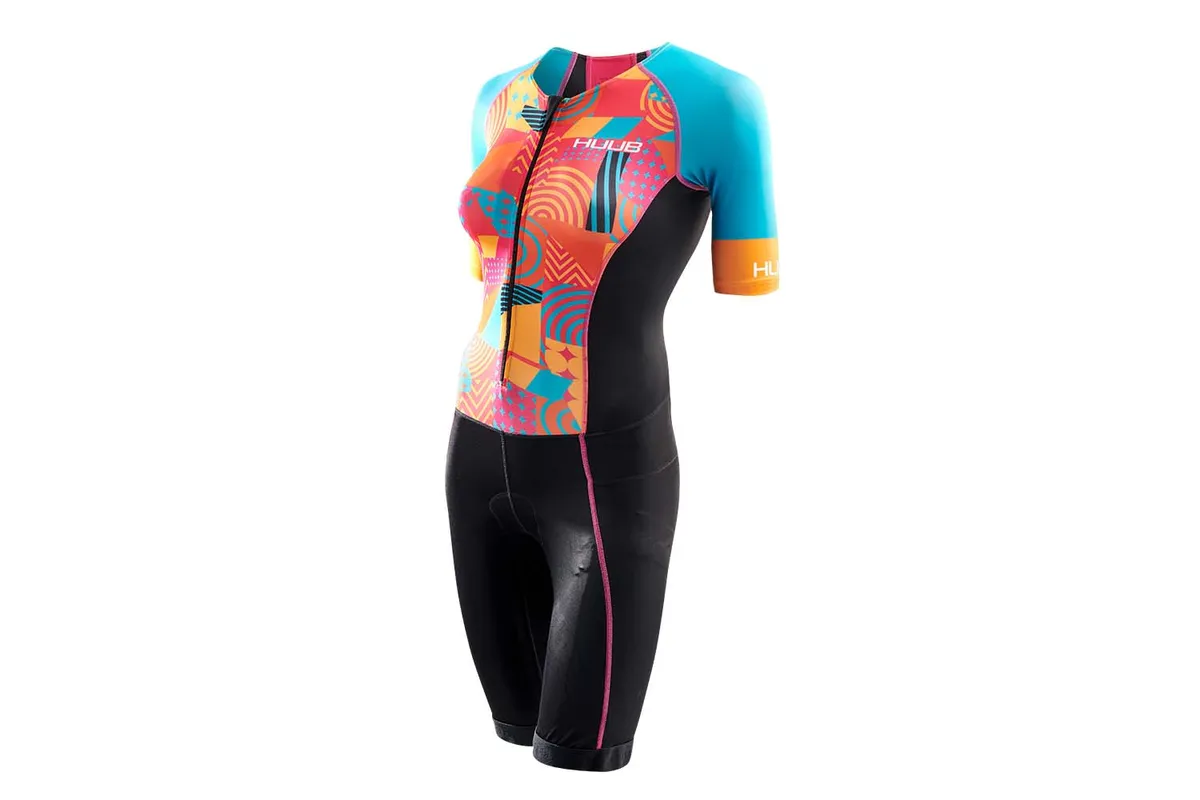
- £139.99 (UK only)
The energetic and fun colour scheme makes you want to get racing just by looking at this suit, the result of a collaboration between Huub and Her Spirit.
Lightweight and flexible, the suit feels like a second skin and provides UV protection for long days in the sun. An open-neck design allows great freedom of movement.
The chamois feels thick and supportive on the bike, but may be larger than ideal when it comes to the run. Despite the leg grippers looking thin, they hold firm and don’t give any unwanted bulging.
Although not littered with aero features, the suit felt slippery in both the air and water. The only negative was the pocket size, with only enough room for two gels in each of the two pockets.
Despite this, as the cheapest suit on test, it wasn’t out of place with those twice the price.
Verdict: A colourful, well-designed tri-suit at an affordable price from a top triathlon brand.
Score: 83%
Stolen Goat Upstart Tri-Suit
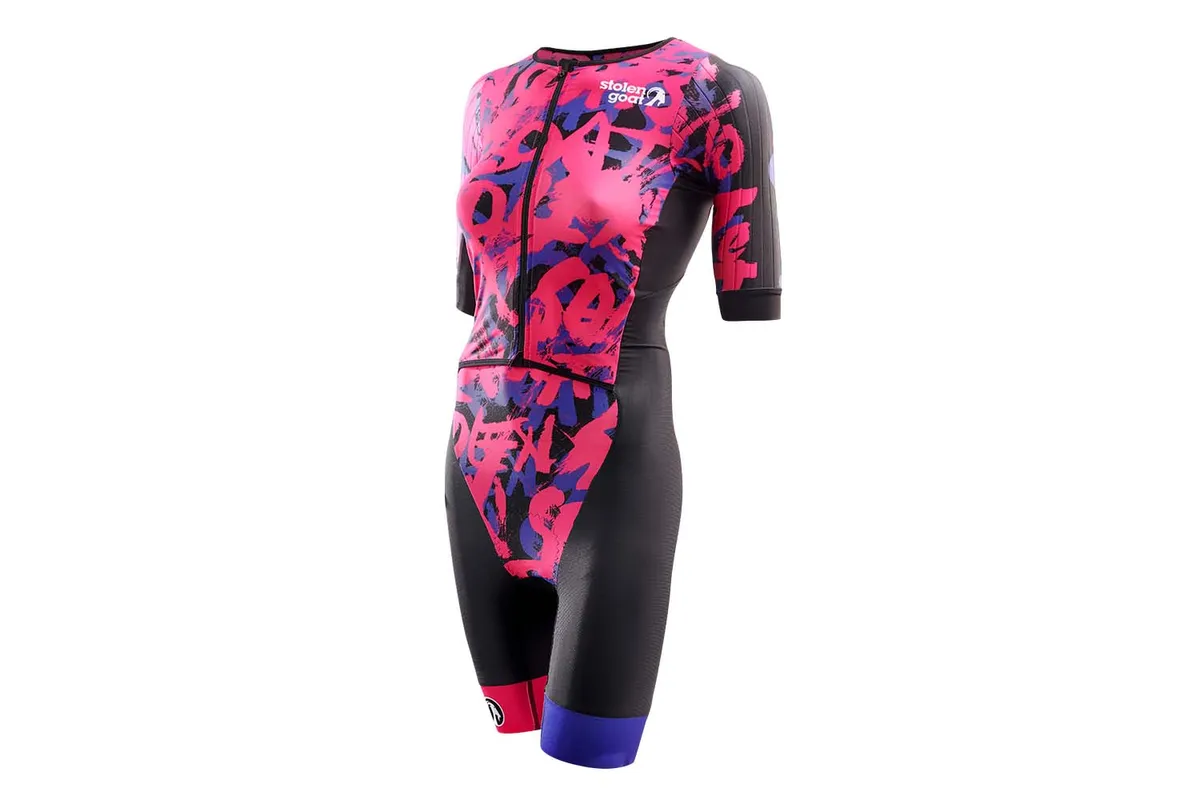
- £160 / $210
Stolen Goat’s vibrant design is striking, but this tri-suit’s about more than just its looks. ‘Airstripe’ sleeves claim to save eight to 10 watts per arm – the equivalent of a disc wheel - with the close-fitting upper body maximising aerodynamic gains.
Thankfully, the four-way stretch material and the split front design allow full flexibility, meaning that the suit doesn’t feel restrictive despite its slim fit.
The Upstart also offers UV protection, while the breathable fabric kept us cool throughout testing. The two large rear pockets comfortably hold at least four gels each.
Wide grippers stay in place, but as the legs come up shorter than others on test, they sit more in the meaty part of the leg, resulting in tightness and a slight bulging effect.
The Upstart’s available in an impressive seven sizes, so it maybe that sizing up eliminates this issue for those with powerful ‘cyclist’s legs’.
Verdict: Performance, comfort and style come together in a package thats fantastic value for money.
Score: 88%
Zone3 Aeroforce-X
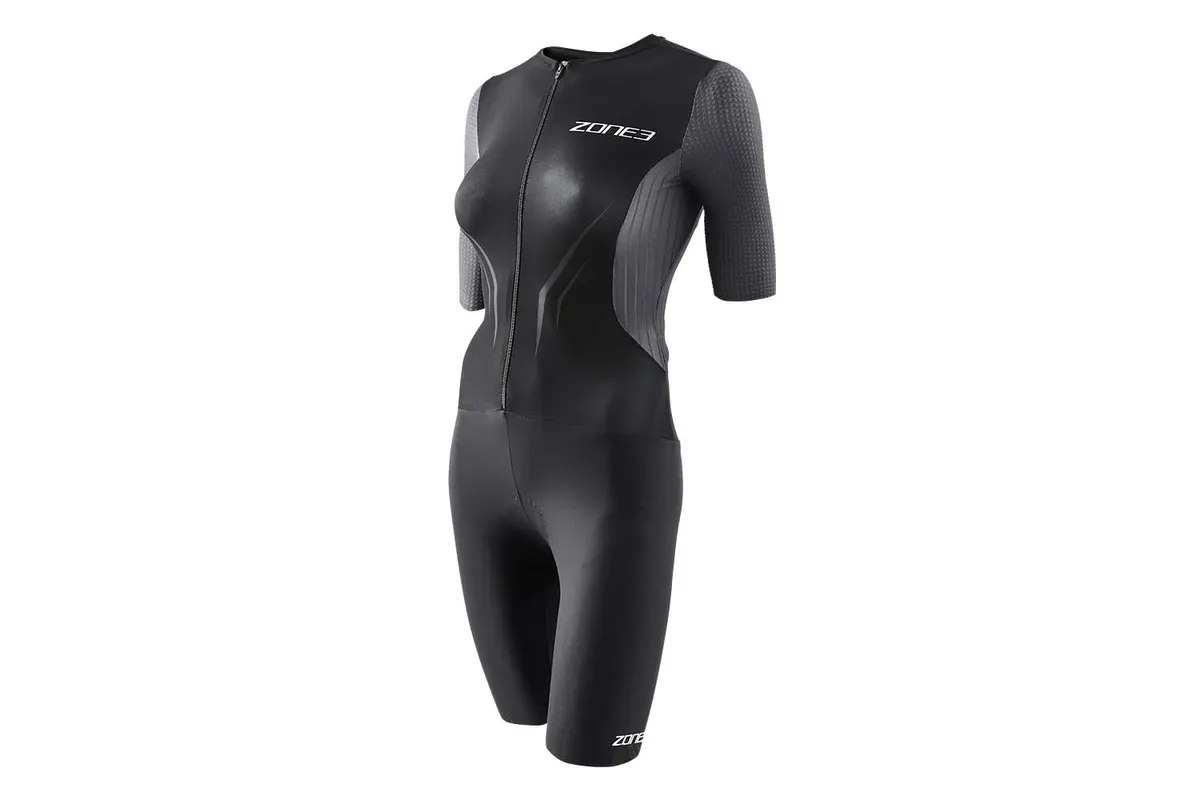
- £275 / $343.80
With claims that the Aeroforce-X is the world’s fastest tri-suit, Zone3 has worked with Nopinz to produce a suit that aims to perform at a range of speeds for all abilities.
Using ‘golf ball technology’, dimpled sleeves and ‘Aerostripe’ sides, the suit’s designed to maximise aero gains, with lightweight panelling on the back to regulate temperature.
Our sample came up short in the upper body, leaving us feeling restricted around the neck, collarbone, and when on aerobars. While supportive, the chammy finished awkwardly on the leg inseam, causing rubbing against the saddle.
By contrast, the lower body fitted well, with the smooth, soft fabric offering core and leg compression and deep aero pockets providing storage for at least six gels.
The suit ticks many performance boxes, but with only five sizes available, taller athletes may need to look elsewhere.
Verdict: Lots to like and impressive tech, but for the price the chamois needs improving.
Score: 79%
Tenola Aspire

- £85 (UK only)
You may not have come across this tri-specific brand before. In fact, this is Tenola’s first outing in a 220 women’s test, but we did see them in our men’s reviews in 2019.
Made and designed in Great Britain by keen triathletes, we like the credentials of this brand. The Italian fabrics and cold-black treatment were nice to see during a heatwave in the testing period.
This suit did a reasonable job of keeping us cool, with mesh panels under the arms helping too, but we did prefer the more breathable fabric of the Airofin on balance.
Less positively, the design felt quite basic and old-fashioned, and the single-strip sticky leg grippers weren’t that comfy and started to peel away from the fabric early on in testing.
Two slanted rear pockets were adequate for an energy gel each, while the chammy was soft and comfortable, if a little bulky.
Verdict: Needs a few improvements; feels overpriced for what’s on offer here.
Score: 68%
Huub Commit Long Course
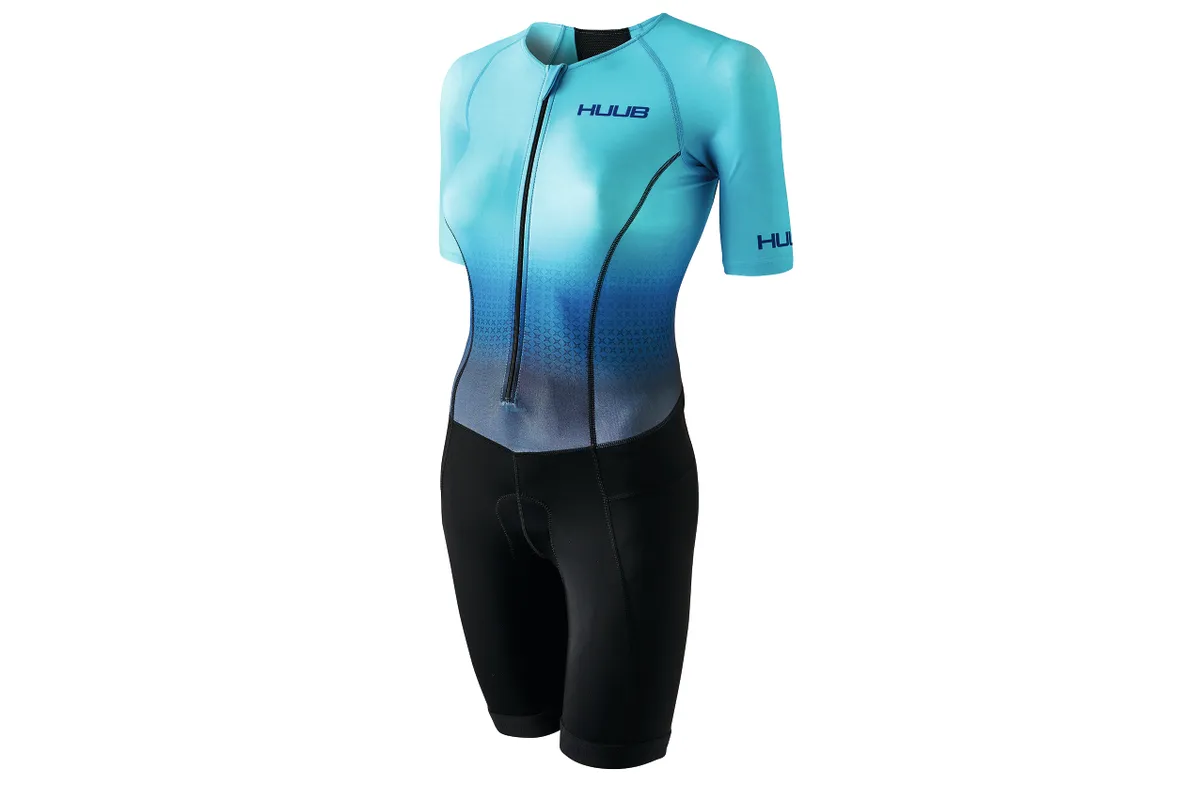
- £139.99 / $180
The Commit is Huub’s new range of quality racewear offering value for money for novice triathletes. That said, we were impressed by the features on offer and the reasonable price point.
We’d happily pay an extra £20 over the Tenola suit here to get a more stylish design (that striking aqua blue on a women’s suit is a winner and looks great when on), as well as the lightweight fabrics that dried quickly and a 3D tri-specific pad that was silky and comfortable.
While it didn’t feel as cool as some others, the fabric felt smooth and nice quality, with a breathable mesh insert down the spine and lower back.
Two angled pockets with fold-over tops kept our gels safe. Our size small suit was a touch tight for this size UK10-12 tester, and we did find the leg grippers a touch unflattering, but that’s easily solved by sizing up.
Verdict: A stylish suit from a big brand that performs as well as it looks and is good value.
Score: 85%
Aptonia Long Distance
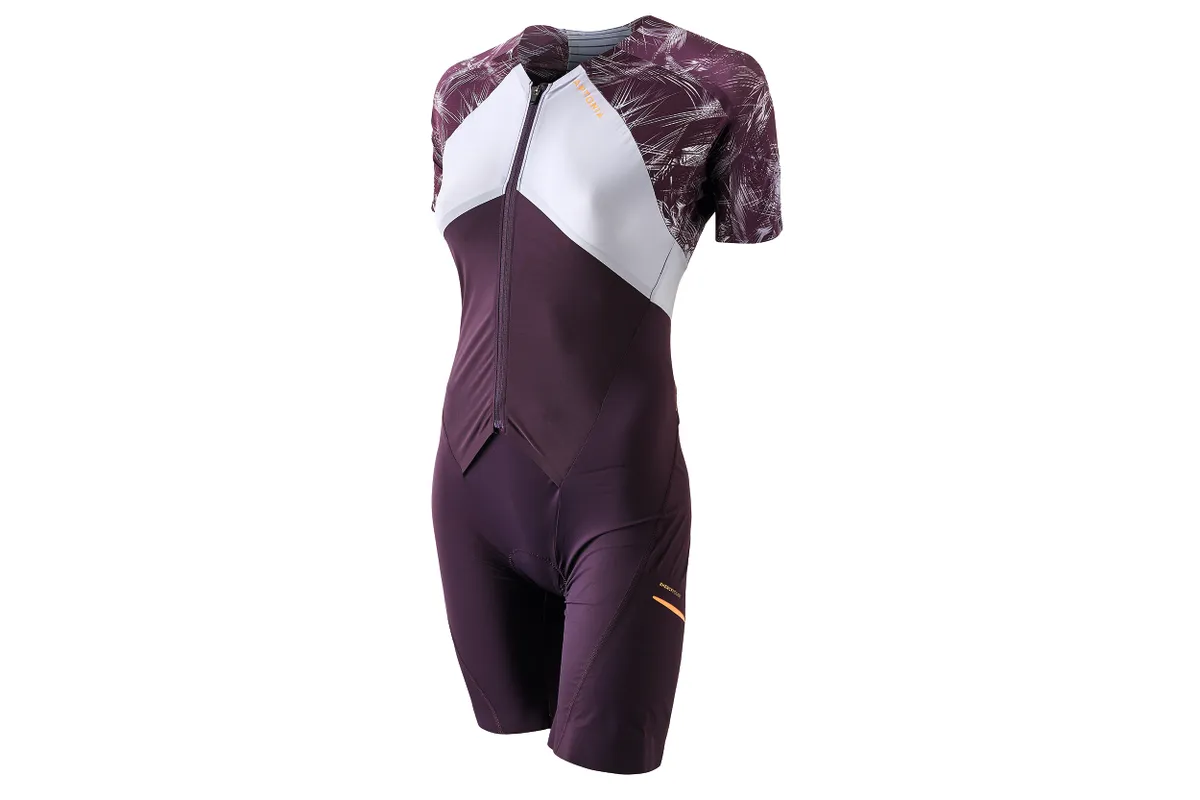
- £39.99
Aptonia is Decathlon’s triathlon brand and we were pleasantly surprised to see such an unusual design sitting at the budget-end of this year’s grouptest.
First impressions on the feel and quality were good. We liked the jacket-style suit, the choice of mesh around the arms and the breathable striped back panel, which kept us cool.
A few quirky touches included a pleat in the back for added movement across the shoulders. This was also the only suit on test to offer four pockets – two mesh on the lower back and one on each leg – allowing plenty of space to stash things for long races.
The chammy is a thin, stretchy gel pad which was quick to dry, but a touch more padding might be preferred for full Ironman distance.
Our only real niggle was the laser-cut hems on the shorts, which were a bit sharp on the edges, though those with slimmer thighs might find them okay.
Verdict: A striking suit with some nice features and among the least expensive on test!
Score: 78%
Santini Viper
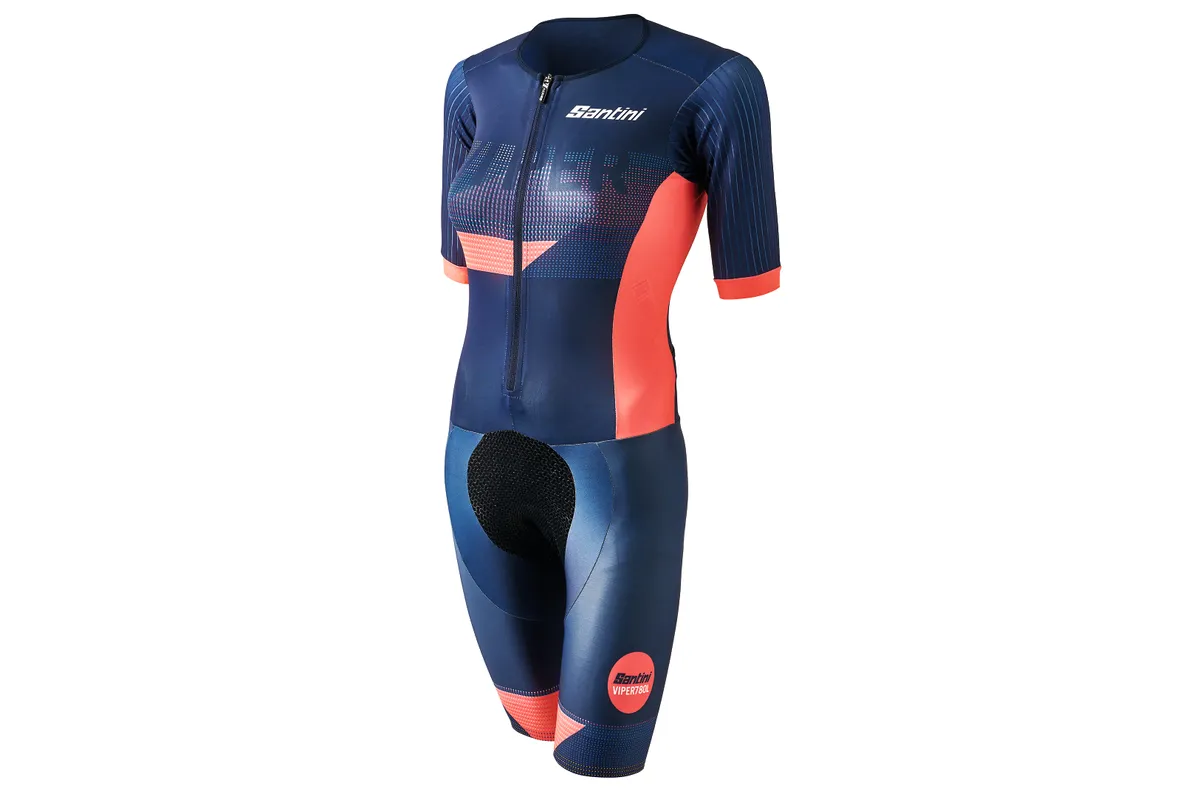
- €159
Kudos to Santini for putting together a suit with a striking design, packed with extra features that the Italian brand claims are designed to help you achieve your ‘fastest bike performance ever’.
This is a bold claim, but we did like the feel of the fresh-touch Artico fabric and the ribbed aero panels on the arms. Overall, the fit on our size medium (size UK10-12 tester) was good, although it did feel a bit short in the body on the run, so we’d be tempted to size up, as is often the case with some of the more top-end ‘race fit’ brands.
The chammy was among the best on test, but although we understood the sentiment, we didn’t really get on with the large grippy area on the crotch, which is designed to help you stick to the bike.
For us, it seemed unnecessarily large and perhaps more suited to time triallists than to triathletes, as it felt odd to run in. Grab yours from Santini.
Verdict: Some great features, but this tech-packed suit did feel quite bike-specific.
Score: 80%
Best men's vested tri-suits
There are still numerous cases for a vested tri-suit. Firstly, a vested tri-suit will often be cheaper than a sleeved version simply because there’s less of it – it’s easily possible to pick one up new for £50 or less by shopping around online or in specialist shops.
The next consideration is the extra restriction that some triathletes perceive to feel in a short-sleeved suit under a wetsuit.
Even now with super technical tri-suits that are purpose-built to cause minimal swim restriction, some fussy pros are still sceptical and opt to roll theirs down to the waist, before putting it on properly during the run through T1.
Dhb Aeron Sleeveless Tri Suit
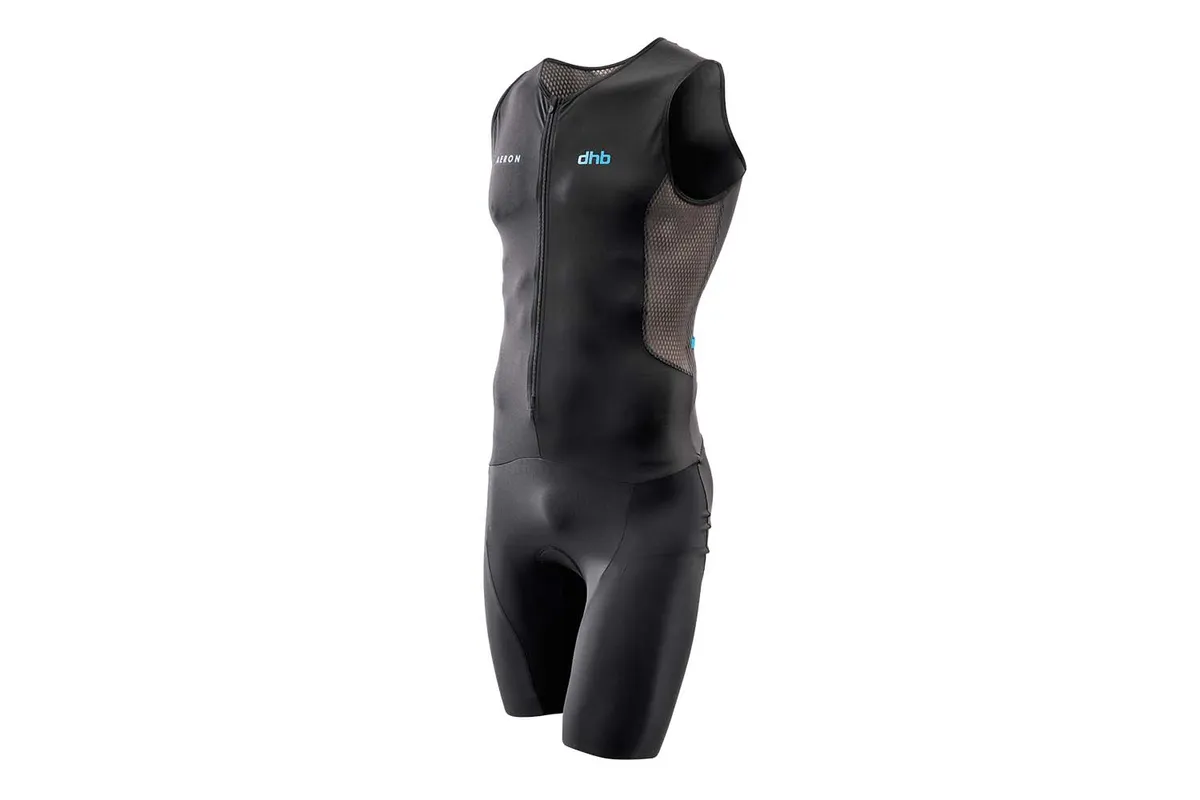
- £120 / $150
Dhb’s Aeron range regularly punches above its fiscal weight, and this sleeveless version proves very hard to fault in its tri capabilities.
In the swim the fabrics bead water well, yet the two open rear pockets do cause some underwater drag.
The large mesh panels on the spine and sides are brilliant for breathability, a zipper garage minimises run-leg irritation, while the tacky leg grippers are as good as the lofty competition here.
Despite being billed as ‘suitable for long-distance triathlons’, it’s not something we’d personally want to spend circa 15hrs in due to the moderate pad (almost identical to the Zone3), but those with tougher bottoms and swifter speeds may find solace here.
The pockets can carry a buffet, however, and the suit is already reduced to £85 online, which ramps up the bargain appeal even further.
Verdict: High-quality and smart triathlon touches at a decent price; the Aeron range has done it again.
Score: 87%
Assos Triator NS Speedsuit
- Buy now from AlpineTrek (£203.97)
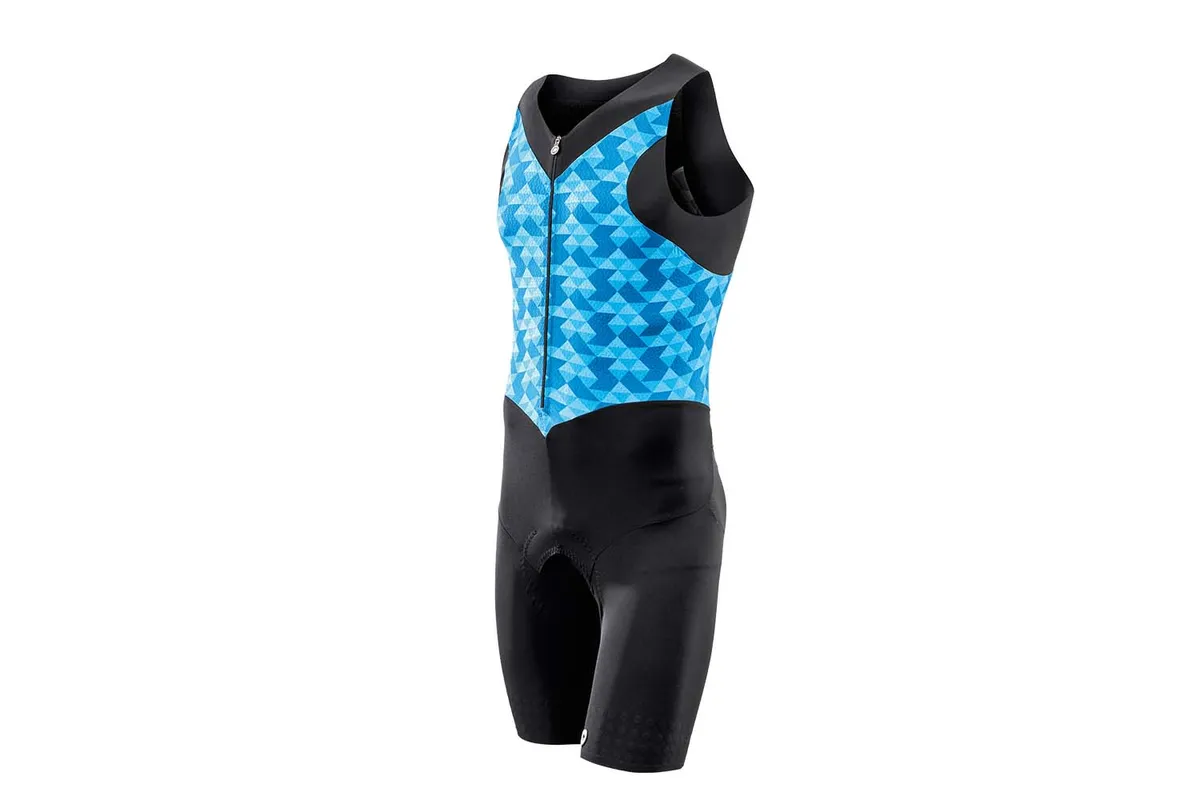
- £340 / $450
This is the sleeveless version of Assos’ unique Triator SS Speedsuit (which is also reviewed on this page).
It loses the integrated ice pockets and, thankfully, the zip that extends worryingly close to the nether regions.
Elsewhere, Assos’s cycling heritage is evident in the supportive, low profile and run-friendly chamois that ticks the long-distance bike-leg boxes.
The high-quality fabric beads water on the swim and the cut in the arms ensures a decent range of movement.
It’s swift to dry on the bike and the textured material’s targeted at aerodynamics (not that we’ve seen any data).
The two rear pockets are fine for a gel each, but you’ll need a Bento box for more. The leg grippers are minimalist yet effective, but the lack of a zip garage is an odd omission given the mighty price tag.
Verdict: Innovative and ready for Ironman, although the price and lack of zip garage limits appeal.
Score: 84%
2XU Light Speed Front Zip
- Buy now from 2XU (£108)
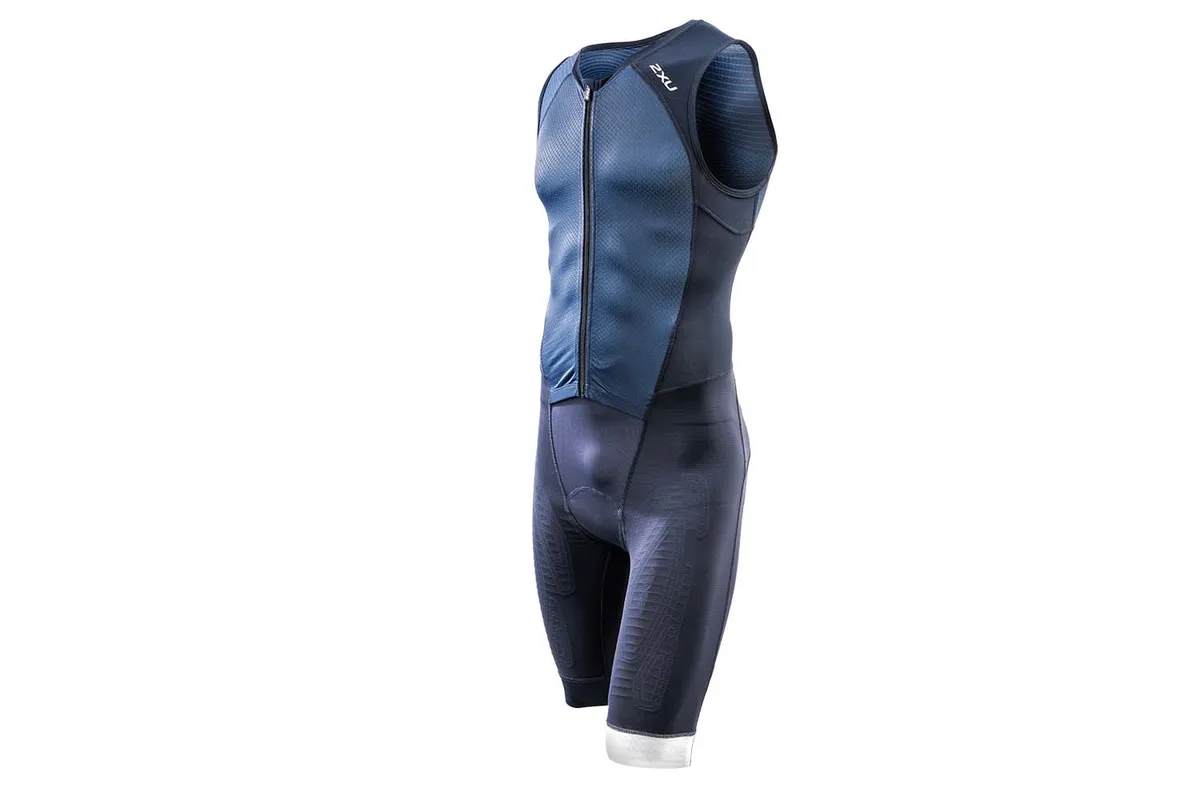
- £180 / $249.99
As befits an Aussie brand, the Light Speed from 2XU would be my pick here for racing in the heat; the mix of lean materials, Coldblack treatment and perforated panels scoring the midsummer points.
Worth noting is that the chest front panel is see-through, meaning nipples are on parade.
The compressive properties seen in 2XU’s celebrated run tights is evident here in the thighs, although we think it’s time for 2XU to update the slightly-too-tight grippers of the long legs, especially when compared to Assos and Castelli’s contenders.
The small rear pockets, which just about house a small gel each, might not suggest so, but the comfy and cushioned pad, full-length zipper and breathability make this our long-distance pick.
Yet the Light Speed will also be at home in any of the tri distances.
Verdict: The most versatile suit here for multi-distance racers, just be prepared to bare!
Score: 87%
Castelli SD Team Race Suit
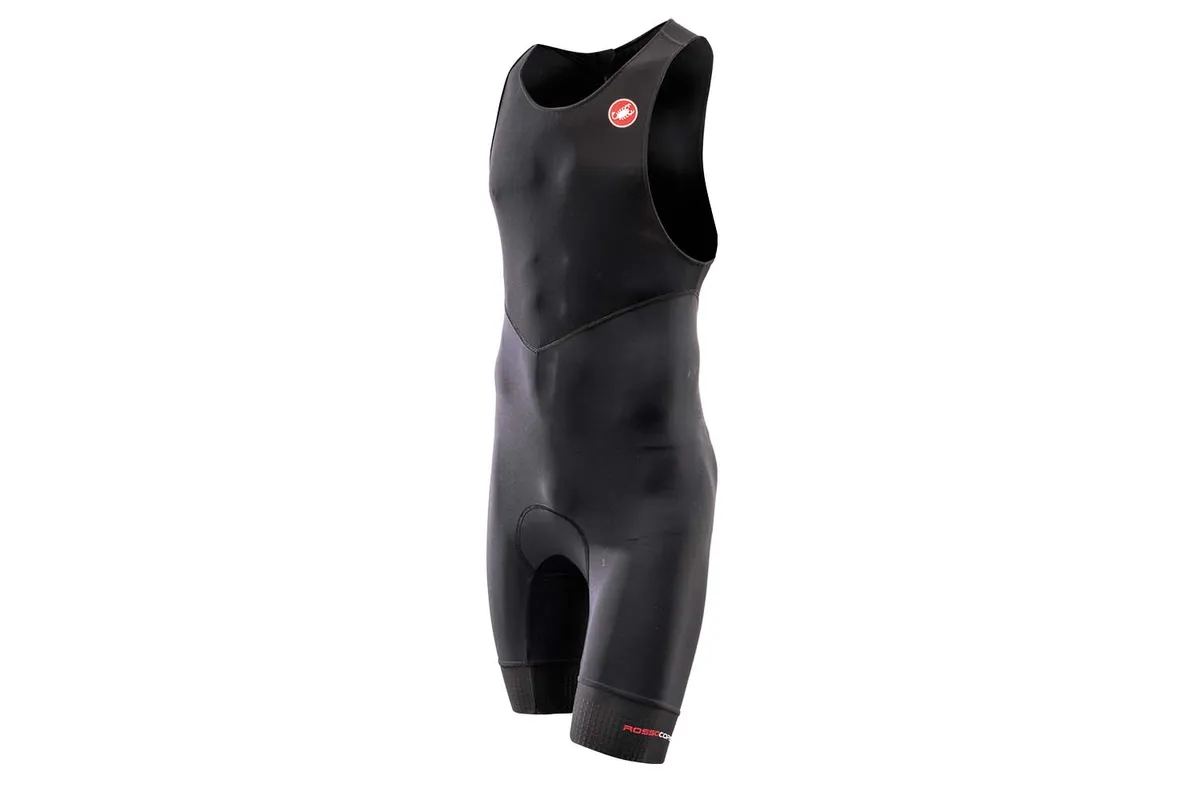
- £210 / $239.34
Planning for non-wetsuit sprint races? Then the SD Team, developed with the German Triathlon Federation, is the one for you.
Were it not for the chamois, it could almost double as a swimskin, with a hydrophobic treatment that beads water, no pockets to increase drag (meaning you’ll need a Bento on the bike for gels), and barely a seam to further disrupt the flow of water.
The cut of the arms ensures the maximum range of movement, even if you’ll need swimmer’s shoulders to pull off the look. And out of the water?
It dries swiftly, but it’s later in the bike leg where problems may arise, given the chamois lacks any serious padding – 20km is doable, 40km a push.
The effective, techy silicone grippers are the usual Castelli class, but you’ll need someone to do the suit up for you before you race.
Verdict: Superb on the swim, but lack of padding and pockets reduces longer bike ambitions.
Score: 80%
Aptonia Short-Distance Sleeveless Trisuit
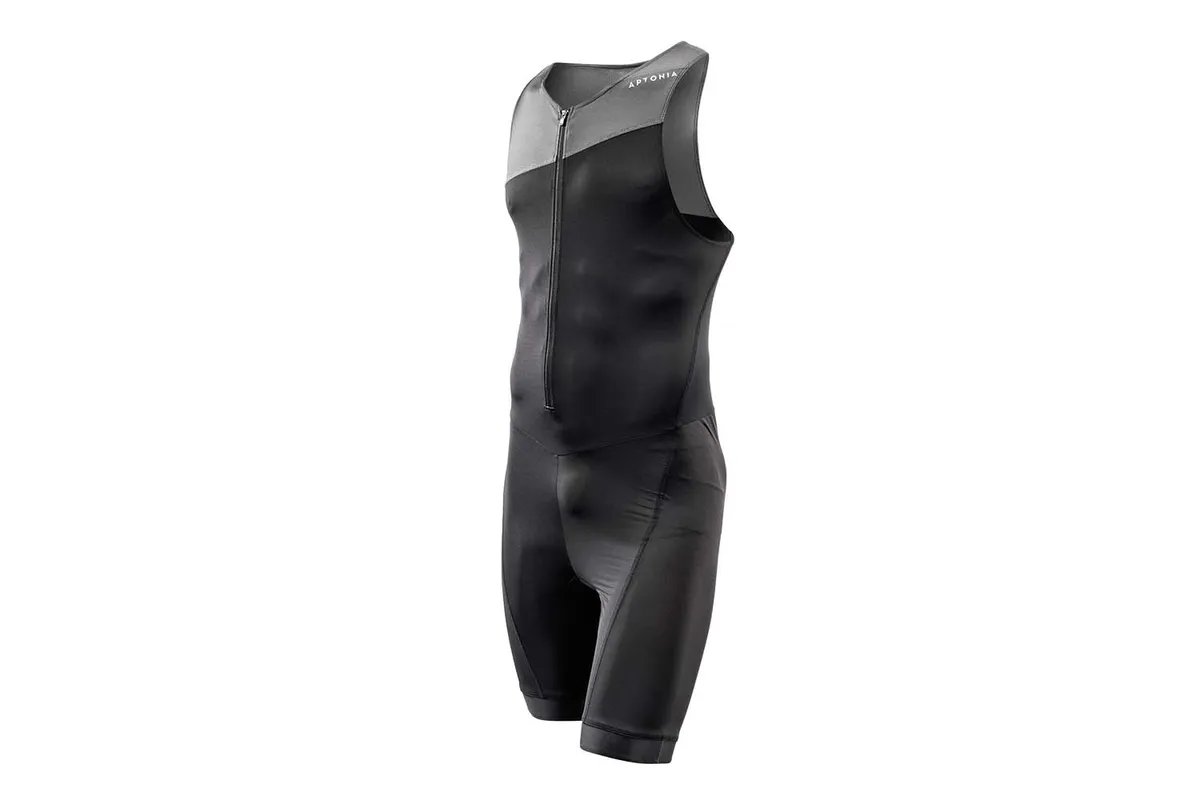
- £49.99 / $69.99
Aptonia’s short-sleeved Short-Distance Trisuit impressed us last issue and it’s much the same with this wallet-friendly vested version.
Again, there’s a mesh strip along the spine for ventilation, a smart leg pocket for gels, a full-length zip guard, and a solid own-brand chamois that can handle short-course tri without proving bothersome on the run.
That’s the good stuff. We’d like some rear pockets for mid-ride and run fuel included while, understandably for the outlay, the material composition and finish quality of the stitching falls short compared to the rest here.
The elasticated grippers are adequate, and the legs come up quite short, while the other colour schemes on offer – navy/yellow and navy/light blue – are more attractive than this dated black/grey number.
Verdict: A few flaws but recommended for those dipping their toes in tri.
Score: 78%
Huub RaceLine
- Buy now from TradeInn (£81.49)
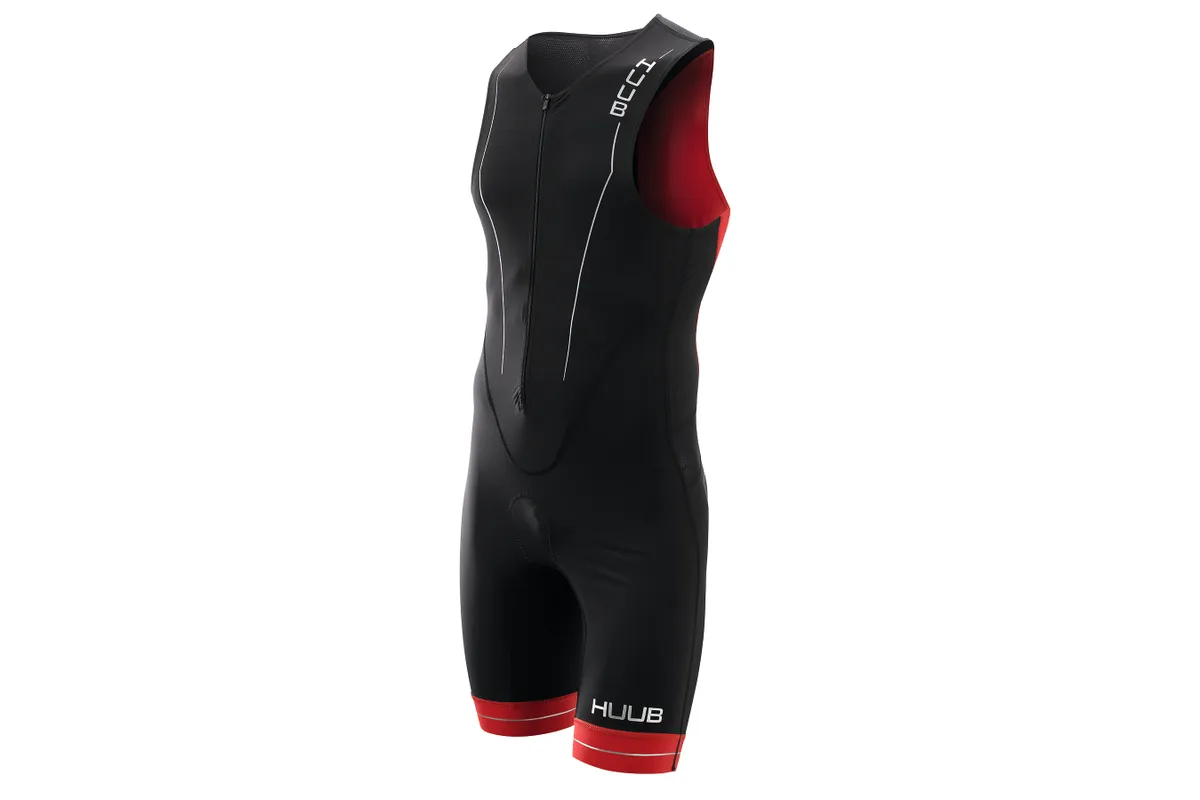
- £159.99 / $184.99
Huub’s Raceline suit has plenty of impressive tech features that we’ve come to expect from the brand in recent years.
High-density chamois with drainage holes, wide leg grippers and two ergonomic pockets that are easy to grab from are some standout features, with lightweight Italian fabrics specced throughout.
Coldblack technology features on the main panels for moisture management, and there are flatlock seams to prevent chafing.
Billed as an aero suit, we found the Raceline offered a fairly relaxed fit, and the legs are on the shorter side, so don’t offer much coverage on the thighs.
The mesh back panel is also minimal, so there’s not much ventilation. But if you mainly race in the UK, that won’t be an issue.
Verdict: Comfortable, technical performance suit that promises some aero advantages.
Score: 82%
Zone3 Activate
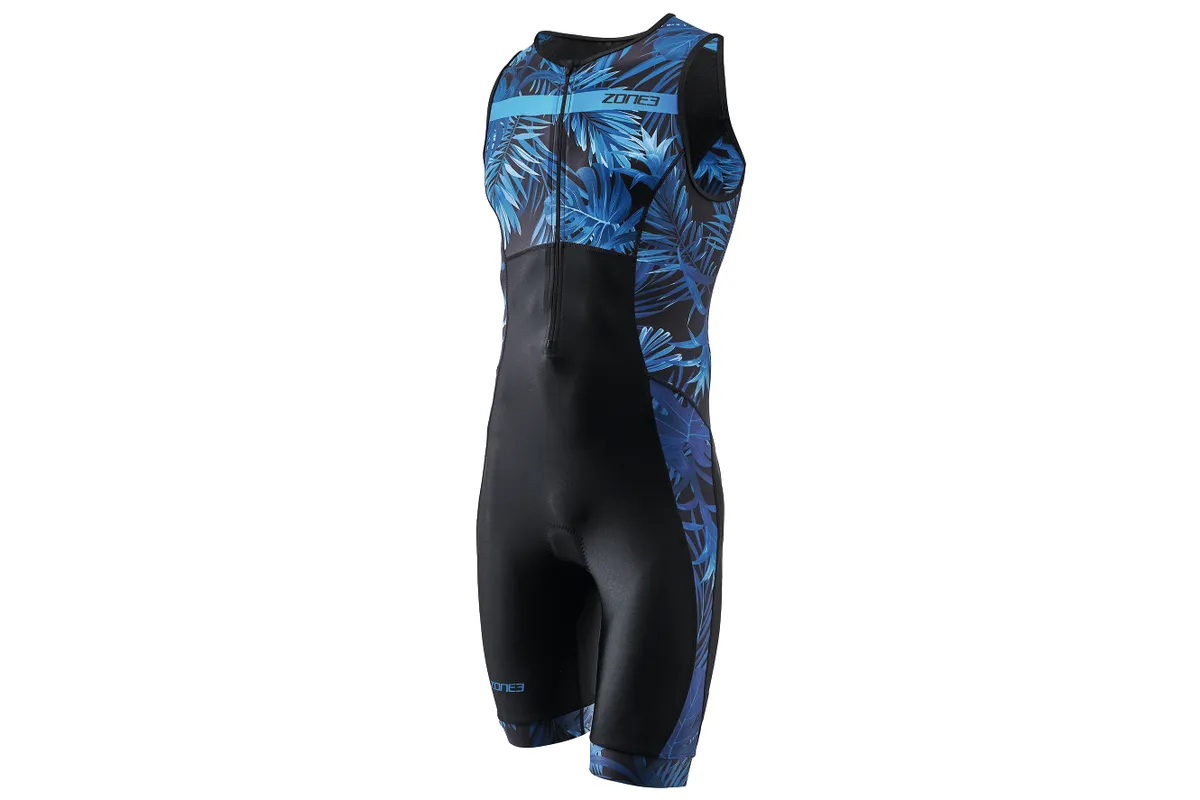
- £100 / $160
The Activate tri-suits from Zone3 had a few upgrades on the entry-level Activate range when they were introduced in 2021. Tested here is the range’s Tropical Palm suit, which is aesthetically pleasing without being too loud.
For a medium it’s a relaxed fit, perhaps more relaxed than we expected considering we’re on the larger end of medium! So if you’re in between, check size guides and size down if necessary.
In terms of storage, there’s one rear pocket with room for a couple of gels, which makes the Activate less suitable for middle distance and above.
Zone3 have specced their Lycra sport fabric for most of the suit, with a thinner, breathable mesh panel on the back that kept us cool during hard efforts.
Verdict: Stylish and affordable suit that will keep you cool and comfortable in your next race.
Score: 84%
Best women's vested tri-suits
Dhb Moda Sleeveless Tri Suit
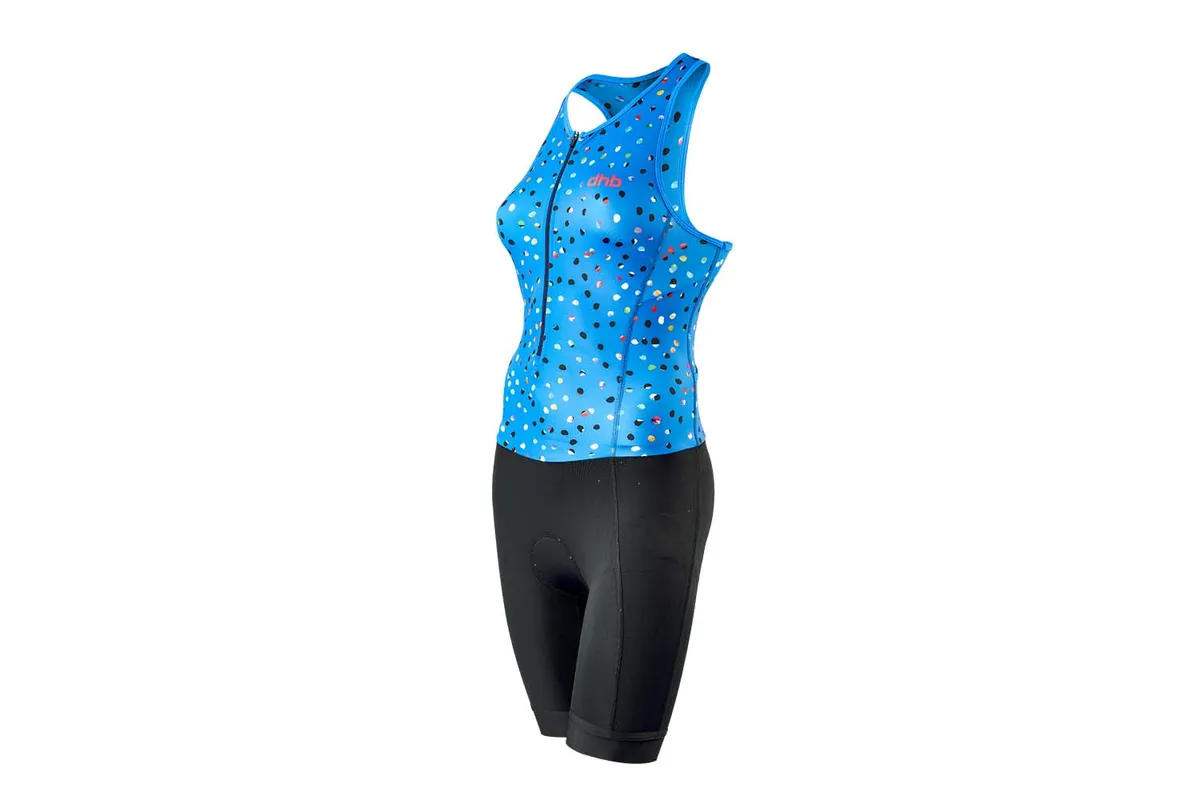
- £70 / $90
The Dhb Moda offers an impressive array of tri-specific features for such an affordable price-point. The Moda’s best suited for up to Olympic-distance events due to the relatively small rear pockets which can fit one to two gels.
The smooth polyester/ elastane body is comfy and we liked the back mesh panel to aid breathability. The ‘moderately compressive’ material did sag a bit on the swim and we needed extra support in the chest for run efforts, though the locking YKK zipper and the leg grippers felt secure.
Along with the Huub, the Moda could be a good pick for sunny racing thanks to its claimed UPF rating of 50 .
We like the Moda’s blue polka-dot colourway and style, and while its chamois is one of the thickest on test it didn’t get in the way when running.
Verdict: Has all you need at an affordable price, though lacking the tech of pricier.
Score: 79%
Huub Aura Triathlon Suit
- Buy now from TradeInn (£81.49)
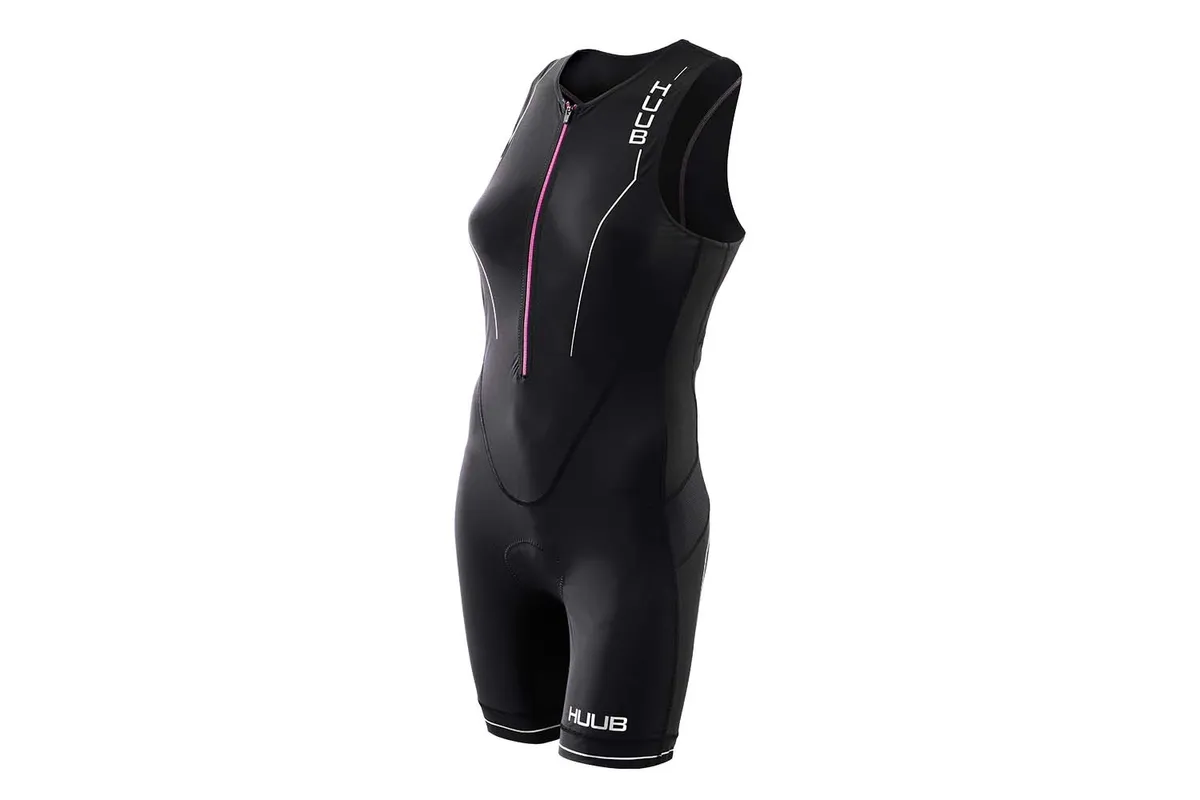
- £159.99 / $199
The Aura is proof that simple but effective’s the way to go sometimes with tri-suit design.
It’s a good pick for racing in hot climes thanks to mesh panels across the lower and middle of the back, along with the ‘Coldback temperature management coating’ with UPF30 which aims to deflect heat and protect the skin from the sun.
The relatively thin but comfy, female-specific chamois and two envelope-style rear pockets that fit up to three gels each are suitable for distances up to half-iron at a push, but we’d want a little more padding for longer.
The 15cm leg inseam’s also the shortest on test (the Tri-fit’s the longest at 20cm), while the silicone leg grippers are comfy but not the most secure.
We felt the most comfortable and at ease in this classy black suit, the fit across the chest also providing just enough support for the run leg (on small busts).
Verdict: Smart and flattering design with features primed for hot racing conditions.
Score: 89%
Tri-Fit Evo Sleeveless
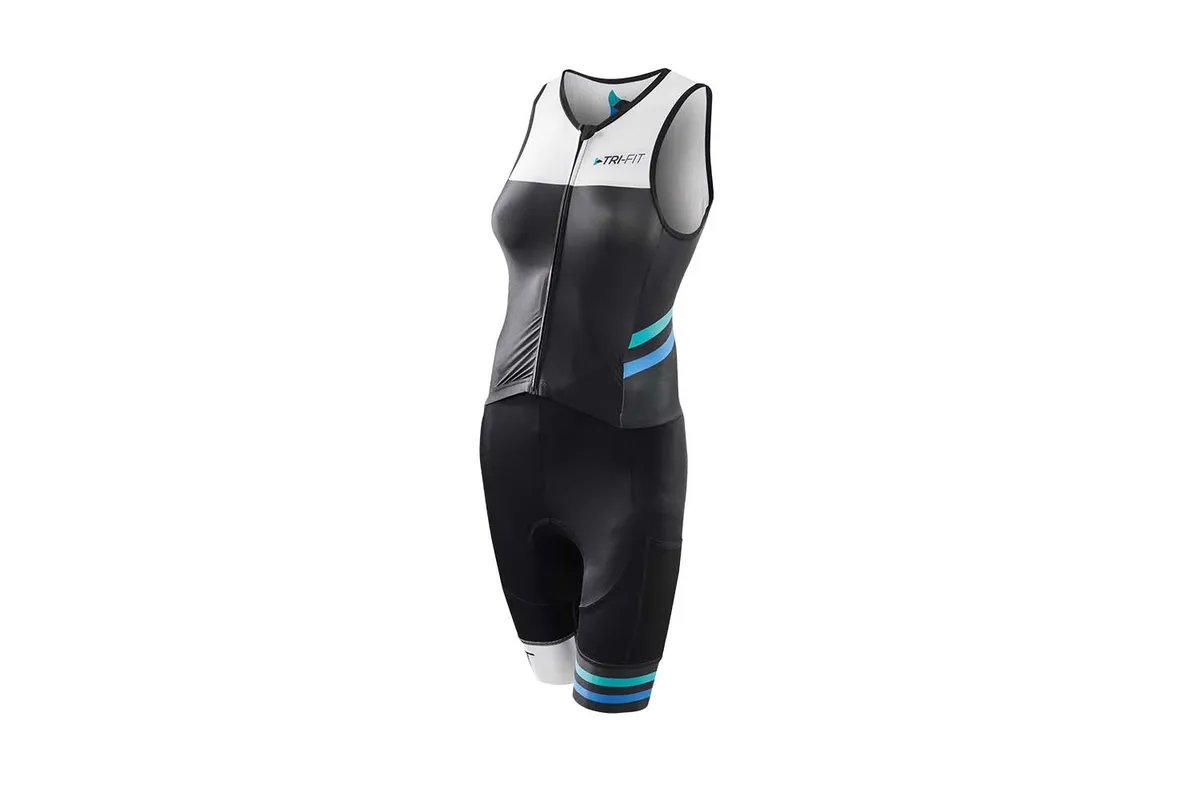
- £159 / $202
The only suit on test to have a split top and bottom design, the Tri-Fit Evo impressed with its well-thought-out features.
Silky smooth material gives way to an aero ribbed back panel which has two built-in, floating pockets that are very easy to access on the bike and run.
The suit performs well for all distances thanks to the substantial pocket capacity and added leg side mesh pockets – easily fitting around 10 gels in total.
The high-density foam chamois has an average thickness and doesn’t feel like an oversized nappy on the run, while also proving quick-drying post swim.
While we experienced no pulling thanks to the split design, we found the silicone leg bands cut into our skin somewhat and the zip garage to be a little scratchy.
Overall, it’s another good suit from Tri-Fit with a quality build, just falling a little short to be our number one.
Verdict: High-quality construction and features, just lacking slightly on comfort for our tester's build.
Score: 80%
Zone3 Aquaflo Trisuit
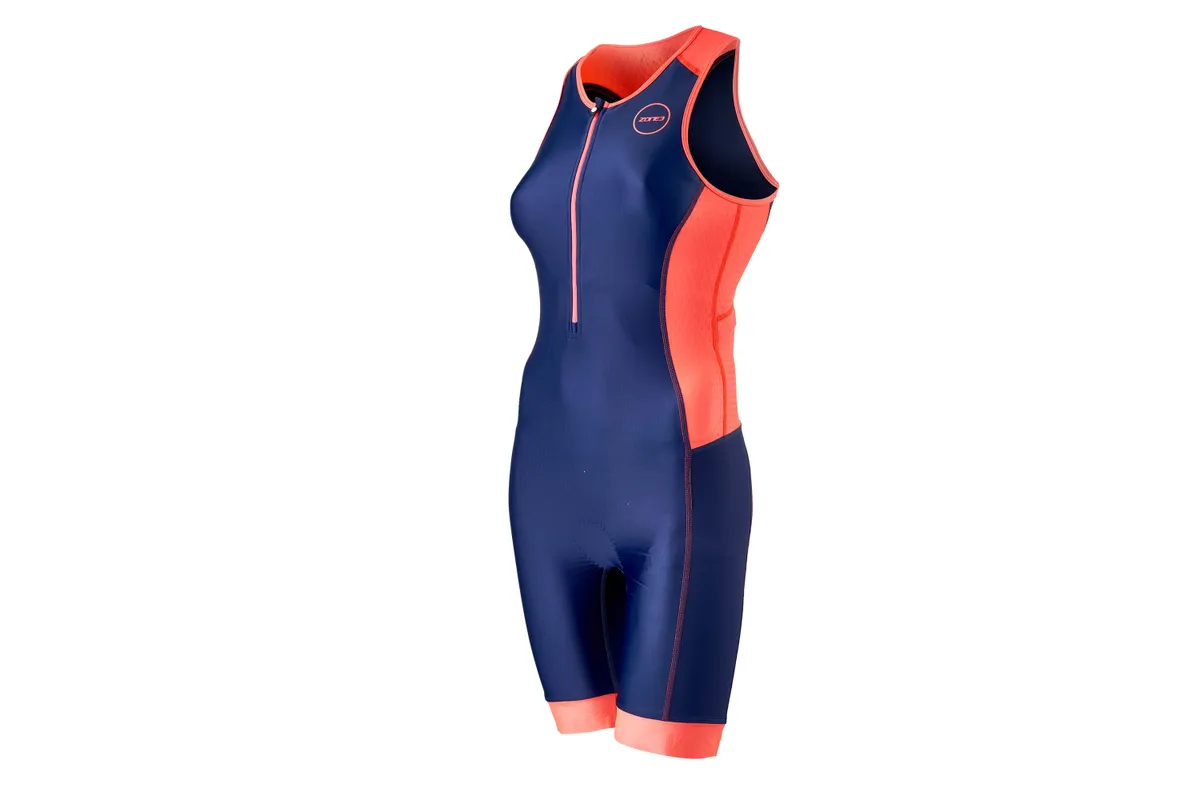
- £109 / $160
The only suit on test to be designed with a ‘double chest layer’, we were excited to try out this updated model from Zone3. Smooth water-repellent ‘Aquaflo’ fabric gives way to back and side mesh panels with two slim and discreet side pockets, which can house two gels each.
Best suited for short-distance, the female-specific ‘Tri-lite’ chamois provides decent padding around pressure points while the leg grippers don’t compromise circulation, actually turning out to be a little too baggy.
A big plus for us is the extra support around the bust area, which helped with comfort on the run leg. While the retro navy and coral colourway isn’t particularly flattering, it was the seams around the zip and chamois that resulted in some pretty extreme rubbing and irritation. Though we had no problems with the sleeved version.
Verdict: Affordable standard-distance suit option, shame the construction caused discomfort.
Score: 68%
Trimtex Drive Tri Skinsuit
- Buy now from Trimtex (€189)
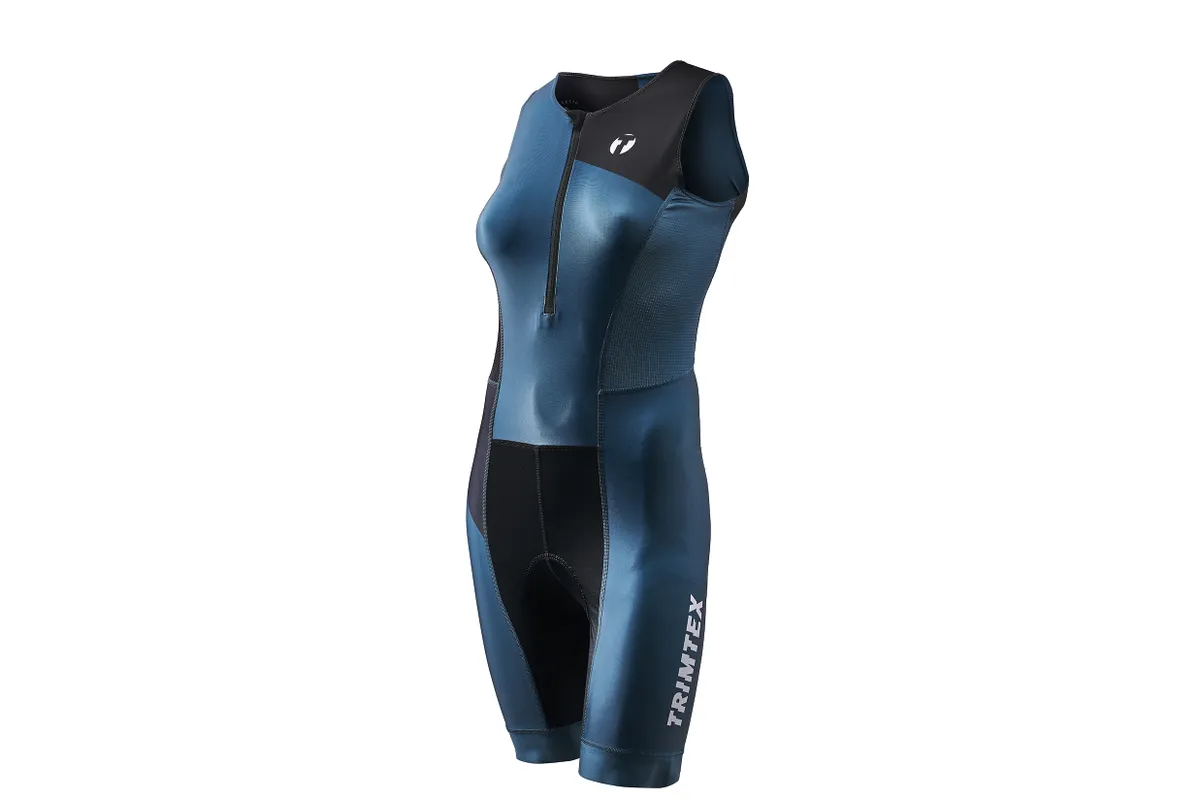
- €189
With Trimtex’s bold claim that this suit has ‘a perfect ergonomic shape’, we had high hopes for the Drive Tri skinsuit, the most expensive suit on test.
First impressions were good, thanks to the practical mesh-panelled design and two roomy mesh back pockets. The material has a soft satiny feel, which in practice proved to be quick-drying and breathable.
The lock zip and zip garage are also good additions for comfort, but the high-rise neckline rubbed at the back, losing it precious points.
We were impressed by the rigorous sizing questionnaire on the website, yet felt the suit ran a little big for a ‘skinsuit’, which didn’t help the non-existent support in the chest.
The real winner here is the wide and über-comfy, laser-cut leg grippers, let down only by the Cytech chamois pad that though claiming to be seamless, felt scratchy on the stitching.
Verdict: Aero offering but lacks finishing details and comfort concerns around neckline.
Score: 77%
Tenola Inspire ITU Style
- Buy now from Tenola (£20)
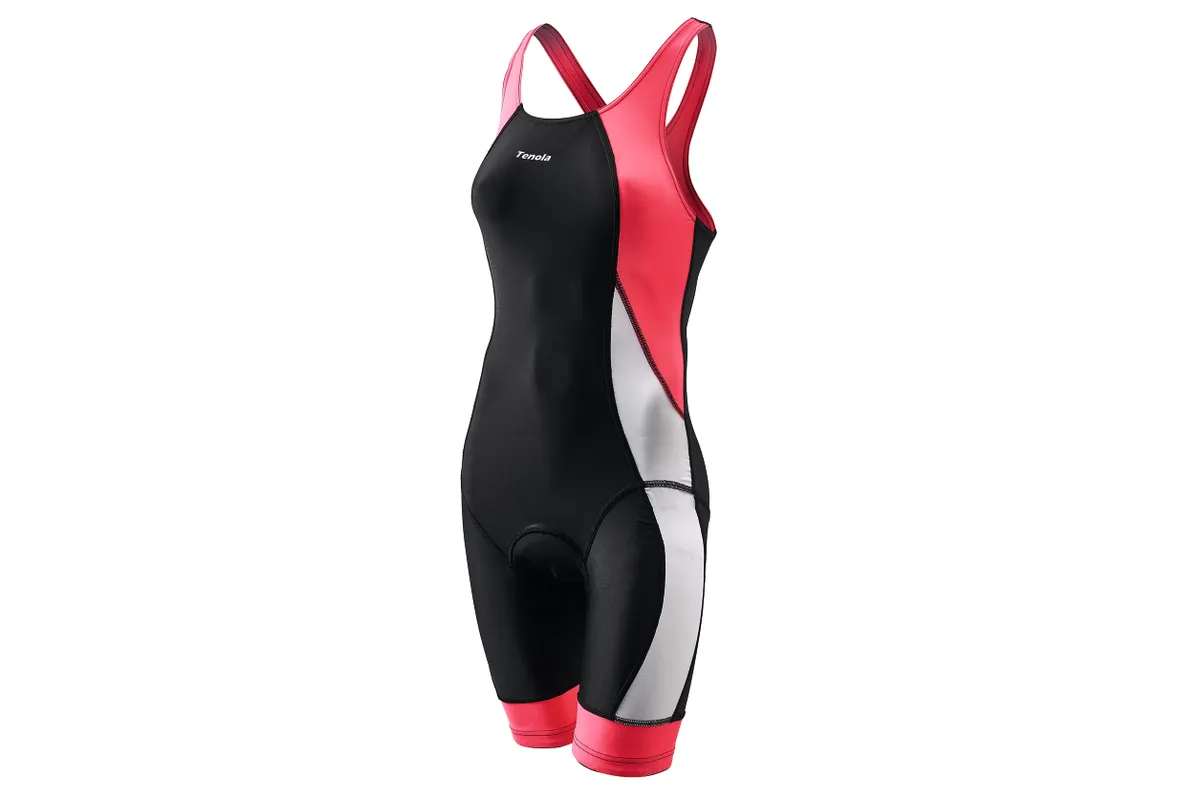
- £20
British brand Tenola officially launched in 2018, with their range of affordably priced race suits, swimsuits and wetsuits.
Their ITU-style suit is primed for hot temperatures and claims to have UPF 50 protection. The cut-out back mimics the classic swimsuit-style and the compressive material is very thin and breathable, supposedly treated to be water-, cream- and oil-resistant.
On the bike, padding is minimal though very breathable and the flatlock stitching reduced discomfort. On the flipside, we found the leg grippers to be too thin and there’s a distinct lack of pockets, which is at odds with Tenola’s claim that it’s suitable for six hours in the saddle.
The slightly oversized chamois becomes a little nappy-like on the run, which is a shame as we’d expect it to fit a little snugger in this area.
Verdict: Primed for sprint triathlons in hot climates; shame about the baggy chammy.
Score: 79%
Castelli Core SPR-OLY
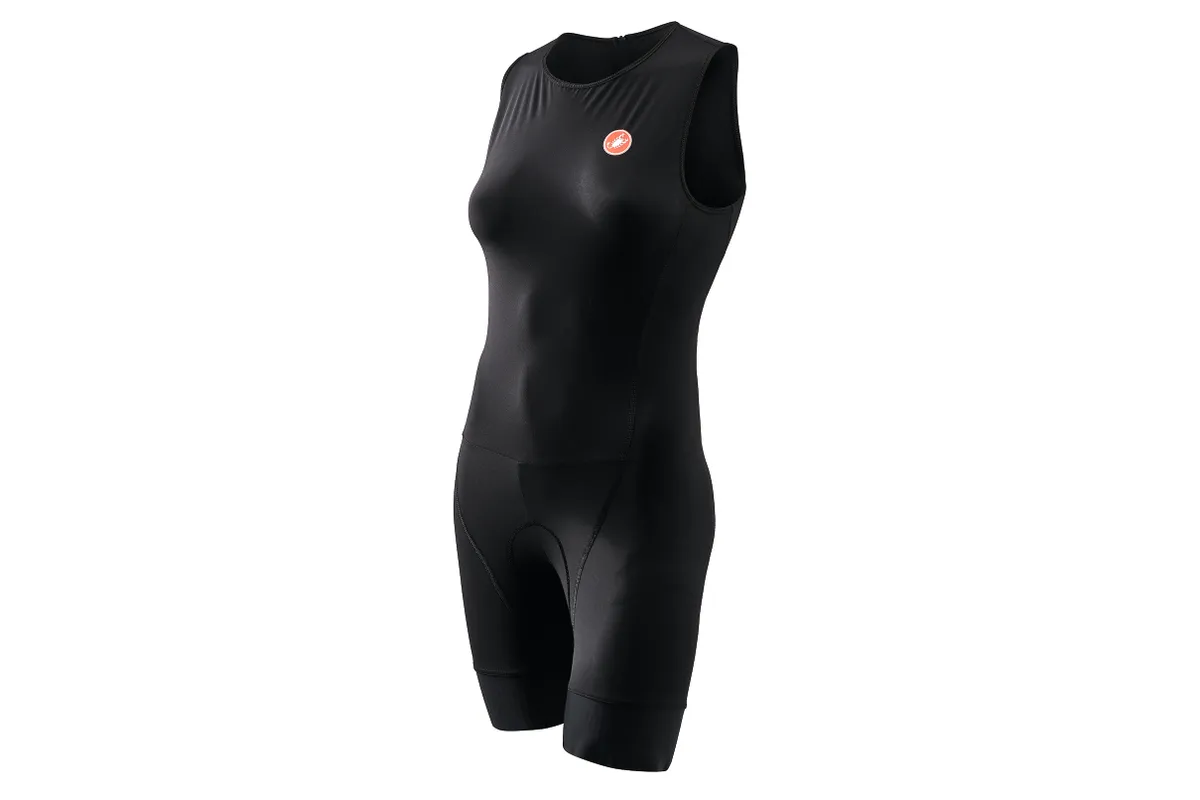
- £120 / $159.99
Castelli’s recent foray into the tri market sees the launch of their cheapest suit, the Core. Despite the basic black colourway, this suit has a lot to offer.
Perfectly true to size, the Core is flattering and fits snug to the body thanks to the reduced seams and elasticated neck and arm holes.
Designed for short distances, the suit has a smooth-to-the-skin felt lining instead of a chamois pad and a quality-feel, lightweight fabric.
The long-line fit, meanwhile, flows down through the legs towards this test’s best silicone leg grippers. In terms of fuelling, there’s one roomy, envelope back pocket that Castelli claim will stay secure on the swim, though we found it difficult to access.
Unlike other suits on test, the Core’s zipper is located on the back with a long pull cord – worth bearing in mind if you like to unzip at the front when hot.
Verdict: High quality build with some nice touches for short-course racing.
Score: 86%
The best Ironman tri-suits
Triathlon brands are increasingly realising the aerodynamic benefits of tri-suits (remember that 80% of drag is caused by the rider, not the bike) and this collection of Lycra is the most tech-happy yet, with fabric boasting dimples, ribs and more all present and correct.
When choosing your Ironman tri-suit of choice, you’ll first need to decide what kind of Ironman athlete you are.
Are aerodynamics worth the added costs that come with wind-tunnel, computational fluid dynamics (CFD) and velodrome action if it means scooping the age-group honours?
Or do you just want something comfy and capable of carrying up to 17hrs worth of fuel to that unforgettable 226km (or 113km) finish-line experience?
Don’t compromise on your choice of tri-suit for Ironman. If it doesn’t fit properly, try another size. Try not to be influenced by a suit because it’s £25 cheaper or is better looking than the one that really works for you.
You’ll be spending many hours racing in your chosen suit of choice and something that bugs you on a 2hr brick session – hello rogue seam, dodgy zipper or soggy pad – will become a full-blown issue on your big iron day. That said, you’ll want to look and feel good in your Lycra armour of choice, so aesthetics does play a role.
Best men's Ironman tri-suits
Huub Anemoi 2 22Plus
- Buy now from TradeInn (£185.99)
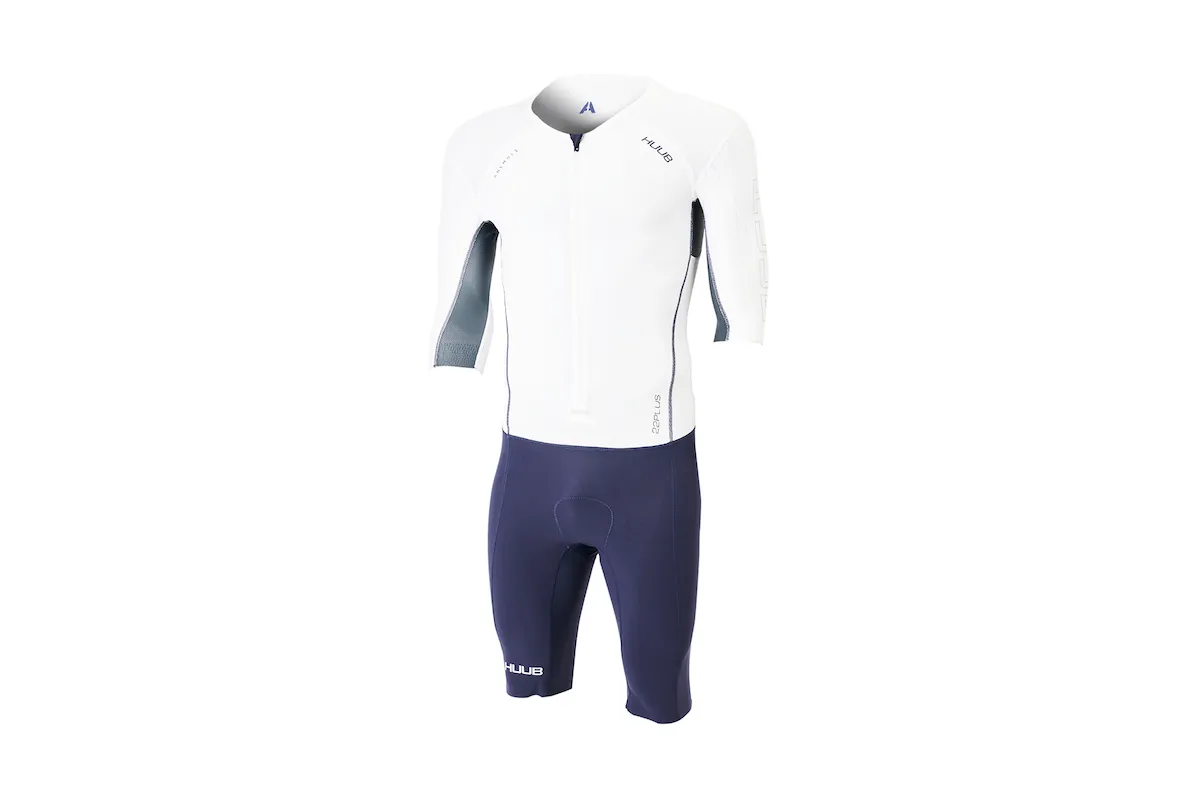
- £299.99 / $TBC
The Anemoi 2 Plus22 is aimed at those that cycle at speeds above 22mph (35kmh), while there's also a Sub22 version (reviewed below) for people riding under those speeds.
Before we get to speed, however, let's first talk about comfort, which is generally very good. There's flatlock seams, impressive flexibility and the zip garage does its job very well indeed.
Meanwhile, the chamois combines support and minimal run disruption to great effect.
Aero enhancements include pinstripes on the sleeves and long-cut legs, plus many, many hours of R&D have gone into making this one speedy suit.
We'd prefer a breakaway zip for easy comfort breaks, plus more storage, but otherwise this is a suit that works over all distances.
Read our full Huub Anemoi 2 22Plus review for more.
Verdict: A speedy suit that's suited to all distances.
Score: 85%
Zoot Tri LTD Aero Racesuit - 40 Years
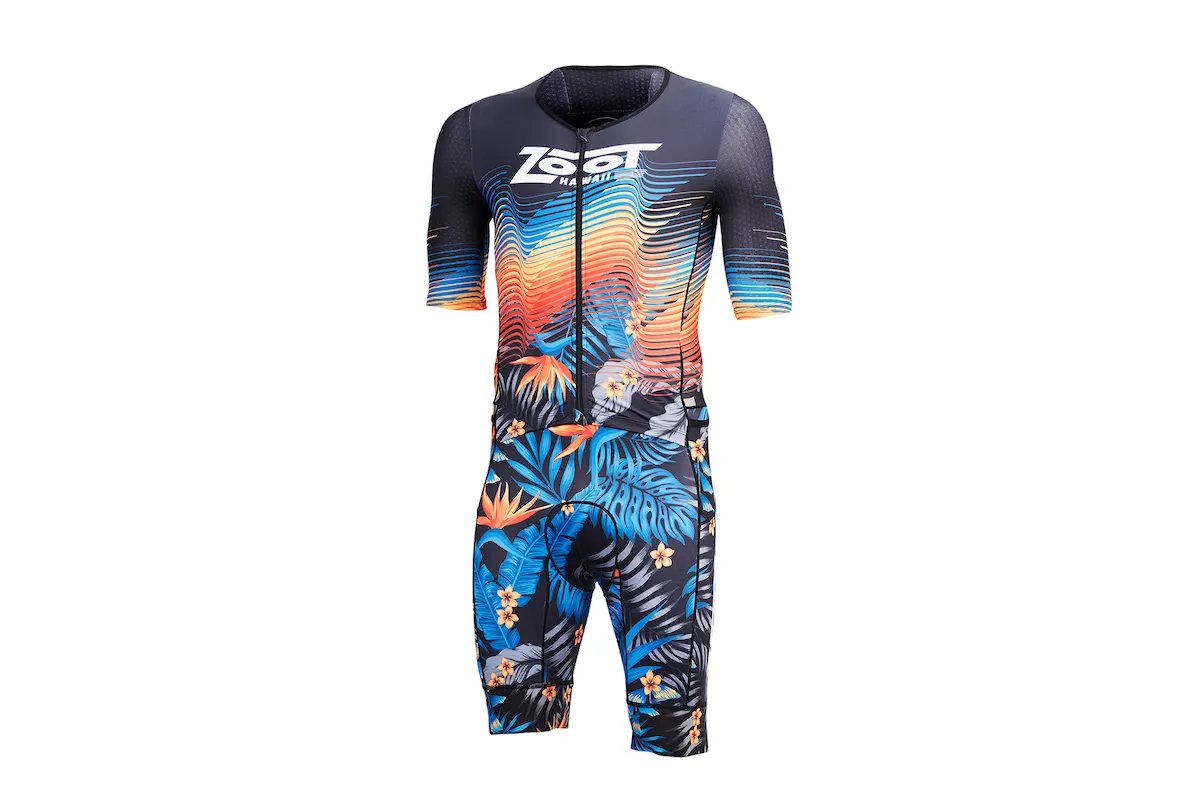
- £225 / $250
Zoot was the original tri-suit pioneer back in 1983 and this suit marks the 40th birthday since Kona resident Christal Nylin started sewing pads into run shorts.
That Hawaiian heritage is evident in the visual onslaught, which we think stays just the right side of kitsch.
But the key takeaway is just how darn comfy this suit is, with a soft Italian chamois with an attached ‘modesty liner’, internal flatlock seams and the smoothest material this side of Barry White.
There’s also a large kangaroo-style back pocket and two side slots for gels, plus the best grippers on test.
Sadly they still haven’t sorted the minimal zipper guard, but the full-length zip makes this a solid choice for mid-event convenience.
The sizeable rear mesh fabric and ice pocket also give it summer racing appeal.
Verdict: Ultra comfort and slick materials, but can you pull off the look?
Score: 90%
Trimtex Aero 3.0 Speedsuit LD
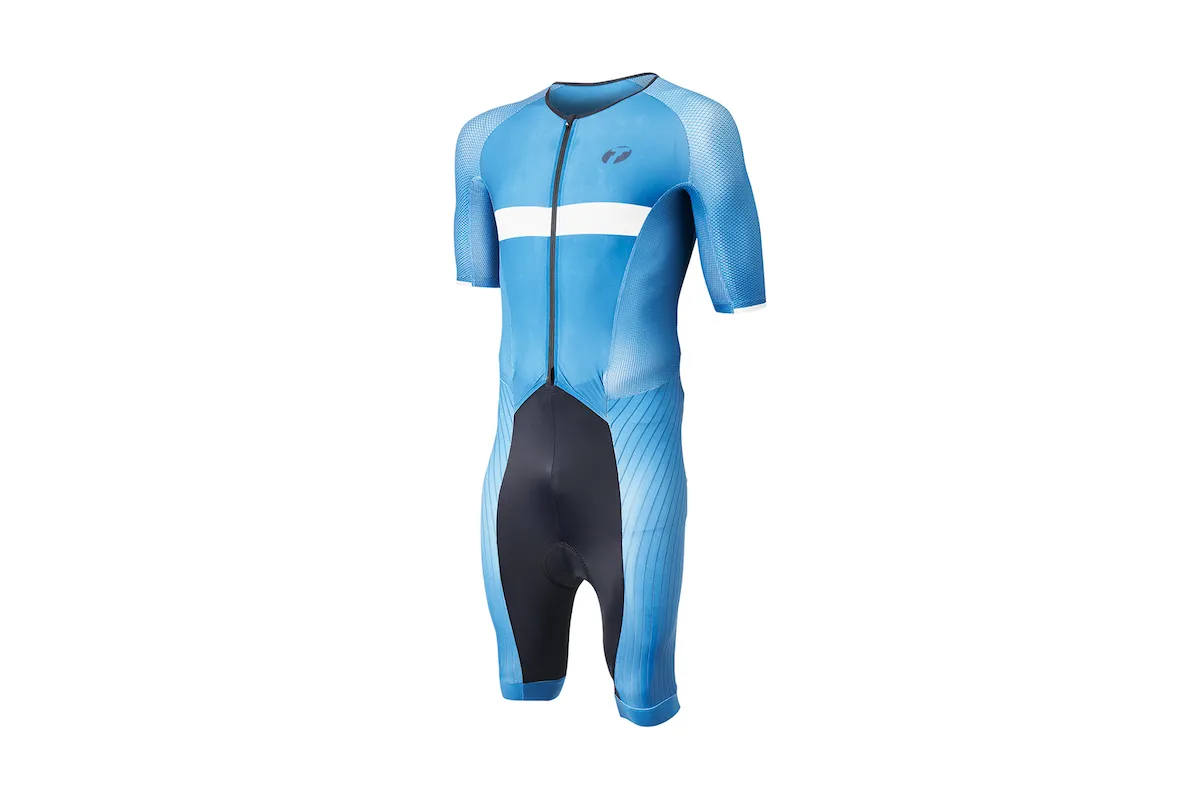
- €359
Norwegian tri superstar Kristian Blummenfelt has worn this suit to record-breaking Ironman 70.3 glory in Bahrain, so we can be content it provides the aerodynamic goods on the race course.
Lengthy arms and legs, dimpled mesh fabric on the shoulders and pinstripe legs all display this aero awareness, while the side-entry rear pockets give a non-wetsuit swim boost.
Improvements over the last version include a full-length zipper guard and a neater finish around the pad.
That pad is admittedly pretty firm, but it felt supportive on long stints in the saddle and seemed less noticeable on the run. We’d still prefer to see flatlock seams internally for the fiscal outlay, however.
Once again, the leg gripper bands are superior, those side pockets are sizeable and secure, and the visuals are solid.
Verdict: Delivers the aero goods, but the outlay is sky high.
Score: 82%
Huub Anemoi 2 Sub22
- Buy now from Decathlon (£299)
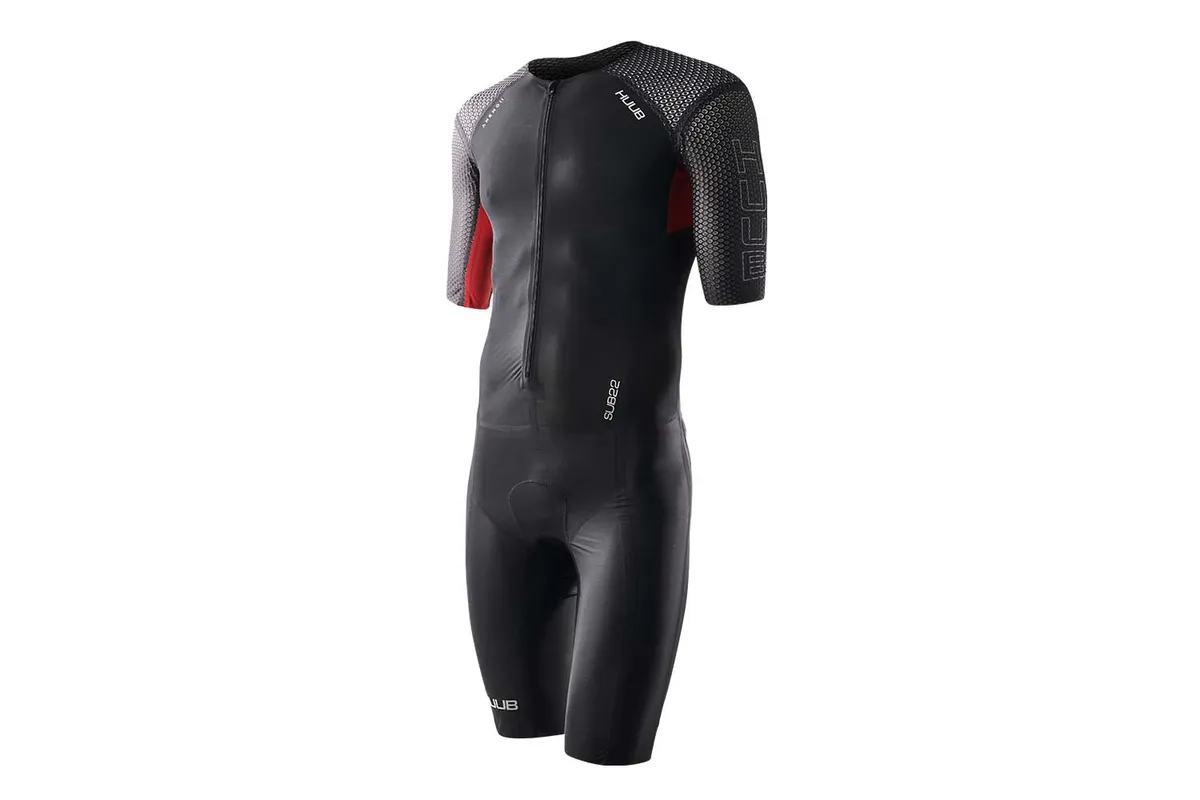
- £349.99 / $402.50
Huub has pulled out all the stops with the Anemoi II suit. We tested the Sub22, which is for athletes expecting to ride at 22mph or below (the majority of the field at a long-distance race).
There’s also a Plus22 version with a few tweaks for those who race faster. Huub says the suit solves ‘Drag Crisis - also known as the Eiffel paradox, a phenomenon in which drag coefficient drops off suddenly as the Reynolds number increases’.
We have no idea either. But it’s fast. Very fast. Once you get it over your thighs, the fabric hugs, but isn’t intrusive. The chamois stood up to extended saddle time, while the run was comfortable.
Bonded seams promise a saving of four watts and two rear pockets are acceptable. Being Huub, the suit really comes into its own in the water thanks to the Arm Neutral technology, which is simply fantastic.
Verdict: A tremendous suit that offers compression and comfort in equal measure.
Score: 90%
Tri-Fit Geo
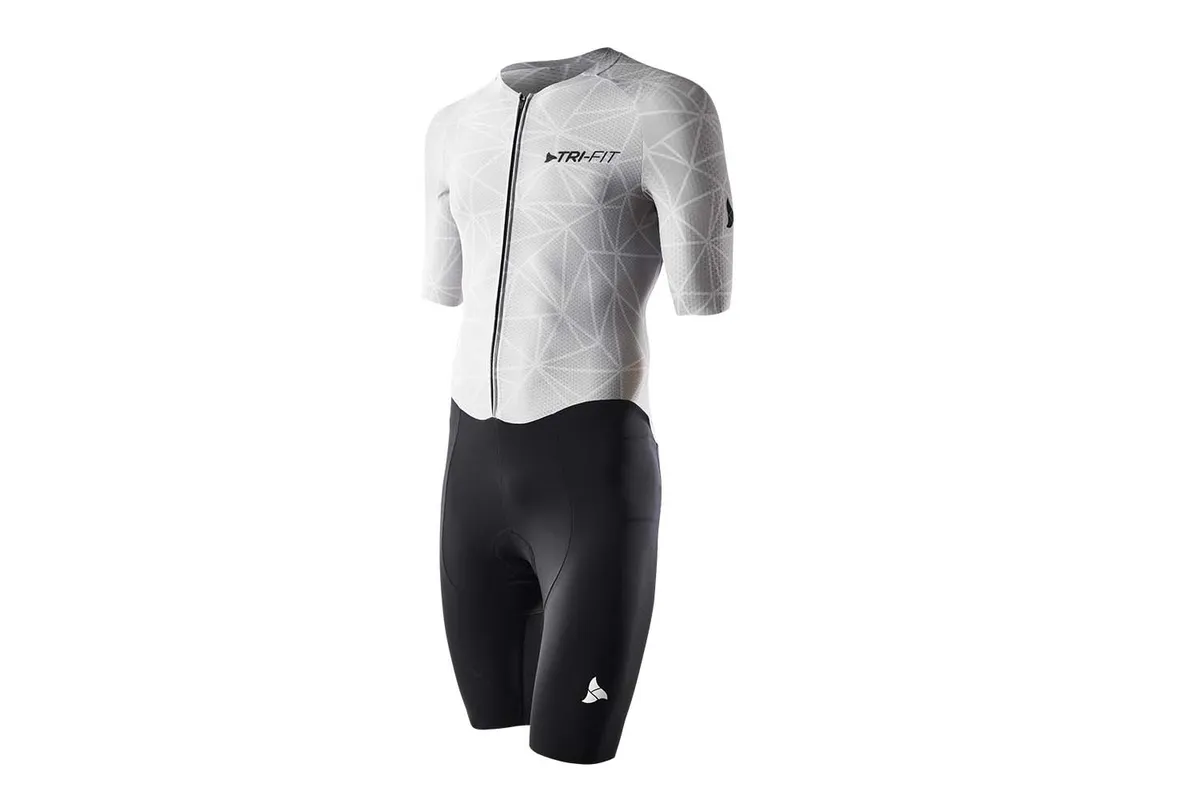
- £219 / $278
There’s a lot to like about the Geo and it’s clear loads of thought has gone into its design. Neat innovations like side-access rear pockets reduce drag but not storage, while the laser-cut hems give a supremely comfortable fit.
The star of the show, though, is the chamois, which is about as comfortable as you can get. The Tri-Fit team are considering upping the thickness beyond this model, widely used by their pros, but there’s no need.
It’s magnificent. Swim performance was solid and on the run the longer sleeves provided added sun protection. The fit wasn’t perfect around the arms and the colour scheme’s a little uninspiring, but that’s subjective.
The suit is is highly competitive in the mid-range price bracket, while the female version (not tested in this grouptest) equally impressed.
Verdict: Great value and built for saddle comfort; very impressive all-rounder.
Score: 88%
2XU Aero Sleeved
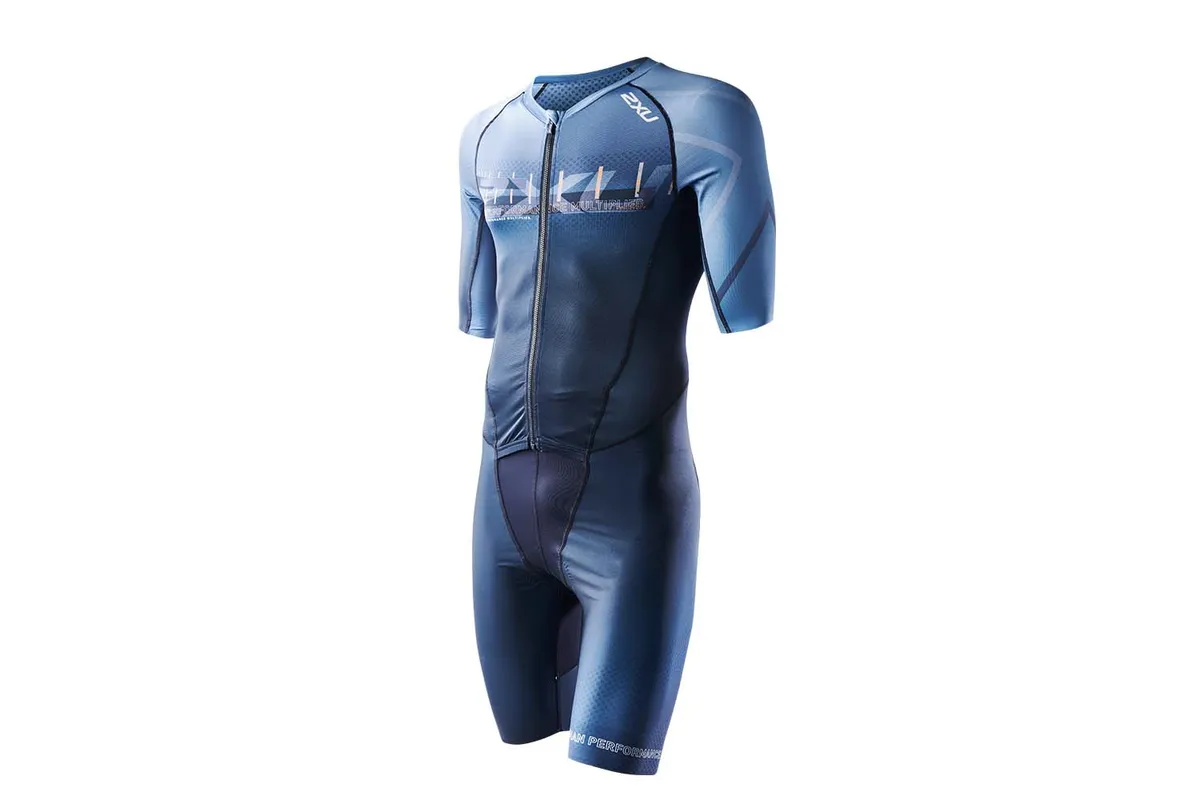
- £160 / $229.99
2XU has an uncanny knack of producing quality kit at low prices and the brand has done it again here. At £130 this was the cheapest suit on test and, while it doesn’t have all the bells and whistles, it deserves consideration due to its value for money.
The seam-free sleeves and excellent fit ensure good aerodynamics and comfort in all three sports. They also promise advanced muscle support (unsubstantiated on this test).
The chamois is decent but not exceptional and the rear storage pockets are more generous than on many suits.
Having the top half only partially attached to the bottom means easy access for toilet stops, which is always welcome in a long-distance race.
The downside is that the fabric doesn’t feel as premium. It’s not a deal-breaker, but maybe this is the compromise for the highly competitive price point.
Verdict: A brilliant suit for those on a budget, but lacks the premium feel that others have on test.
Score: 82%
Huub Anemoi
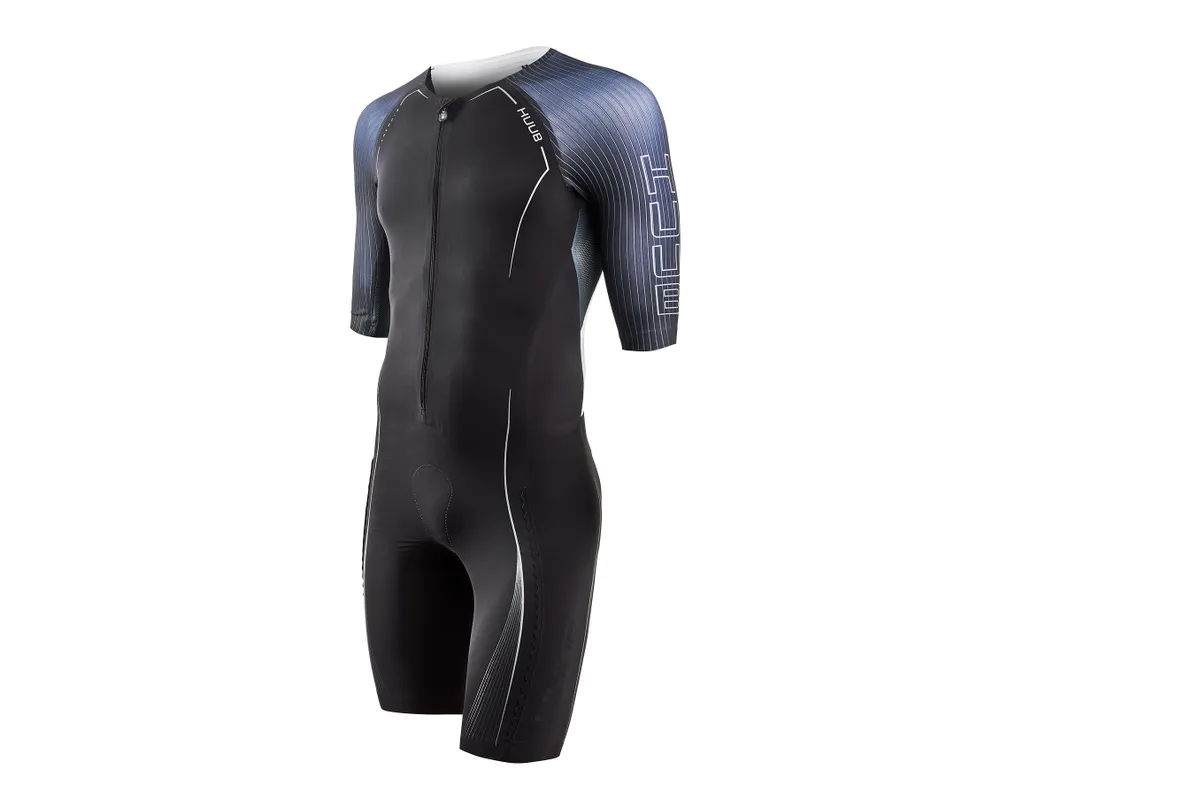
- £229.99 / $355
The Anemoi arrived in 2019 with road-tested changes from the original Anemoi design. The first is the longer zip that makes it suitable for a stand-up wee, and lengthier legs, ribbed arms and bonded seams to increase the aero appeal.
We used the Anemoi on a 3.8km/120km/11km DIY tri in Hawaii in '19. The arms were unrestrictive on the sea swim, the chamois barely there on the run, yet with just enough seated comfort on both the tri-bars and hoods.
It was the new Moov&Cool tech – combined with the underarm venting – that really stood out, and at no point did the garment chafe, itch, allow sunburn or feel laden with sweat.
As a mid/back-of-the-pack athlete who stuffs their pockets with gels, we require more than the tiny solo pocket for racing longer than 70.3. But for triathletes at the pointy end? The Anemoi is a mighty contender.
Verdict: Most impressive, but for the speedsters over the completers.
Score: 85%
Zone3 Lava Long Distance Mens
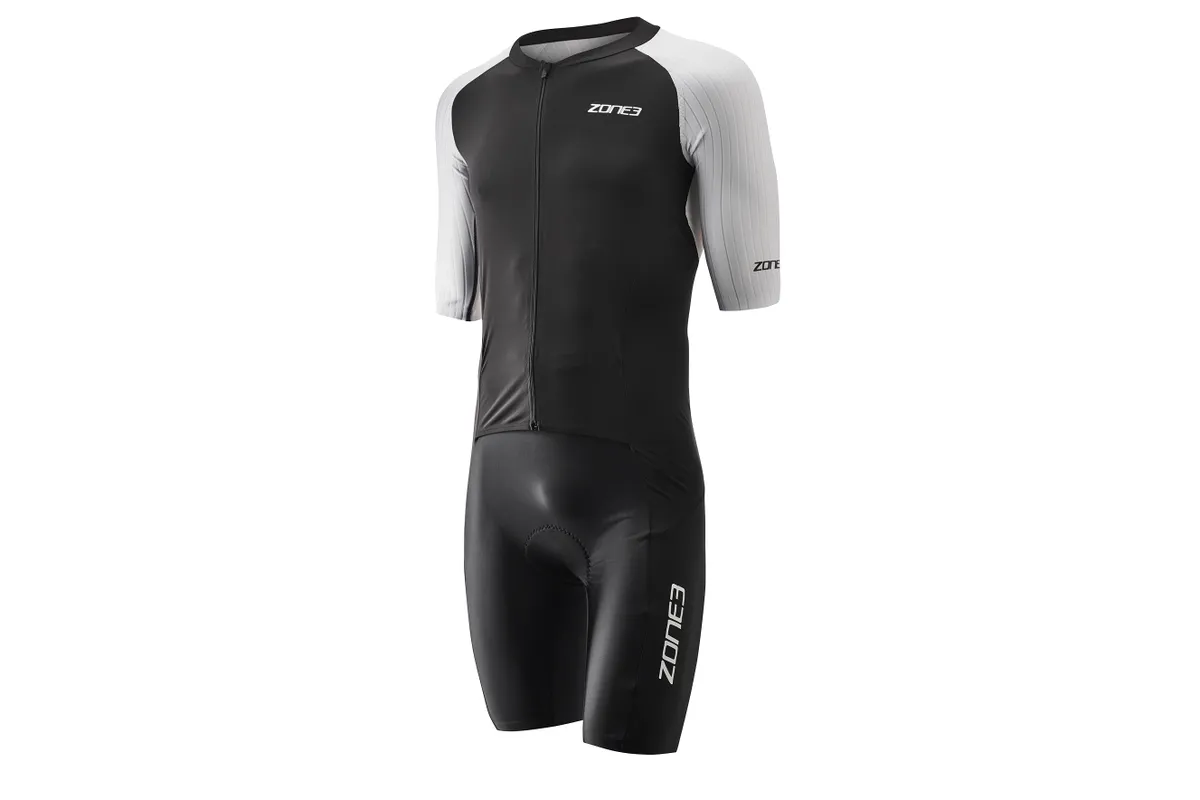
- £219 / $349
After years of not quite making the top-end tri-suit grade, Zone3 blew us away in 2020 with their Aeroforce speedsuit (reviewed above) both in the wind tunnel and on the road.
Much of that painstaking R&D (with input from aero specialists Nopinz) has trickled down into the Lava – and it feels like they delivered the sweet spot between affordability (all things are relative), aerodynamic pursuits and practicality.
Lengthy ribbed sleeves, a full-length zip and supportive Cytech pad add to this winning performance vs practicality ratio.
We were struggling to find faults until we reached for the pockets, which are small, shallow and difficult to access on the move (we wouldn’t trust sizeable OTE gels in them), and, while the pocket’s cover at the top wins swim points, it made stuffing empty gel packets back into them tricky, especially on the bike.
Verdict: Aero, more affordable and just oh-so close to being faultless.
Score: 89%
Best women's Ironman tri-suits
Dhb Aeron Lab
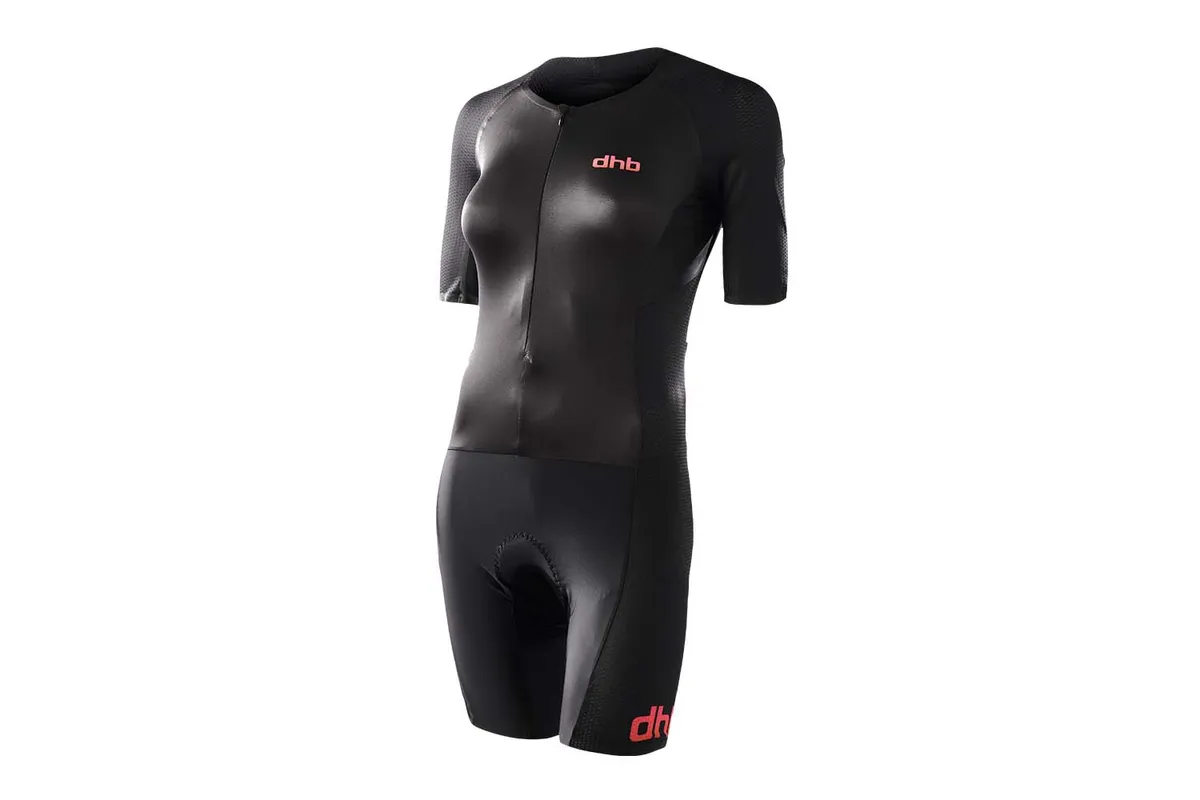
- £200 / $256
Hailed as a second skin, the Aeron Lab feels ultralight and ultra-sleek. The close-fit design, combined with aero-disruptive fabric on the arms, shoulders and legs, aims to provide maximum speed for minimal effort on the bike.
Dhb's top-of-the-range suit offers complete flexibility with the neckline and grippers seamlessly blending into the body to enhance freedom of movement.
However, at 5ft8in, we wouldn’t have wanted to be any taller, so sizing up may be required for longer bodies. Three big rear pockets offered generous storage and the chamois pad kept us comfortable all day on test.
On initial wear, the internal seams were irritating to the skin, but these softened in time and didn’t provide any further issues. It’s worth noting the legs are shorter than others on test, which may or may not be to your taste.
Verdict: Compression supports lacking, but this is a light, flexible and stylish suit.
Score: 85%
2XU Light Speed Front Zip Trisuit
- Buy now from 2XU (from £60)
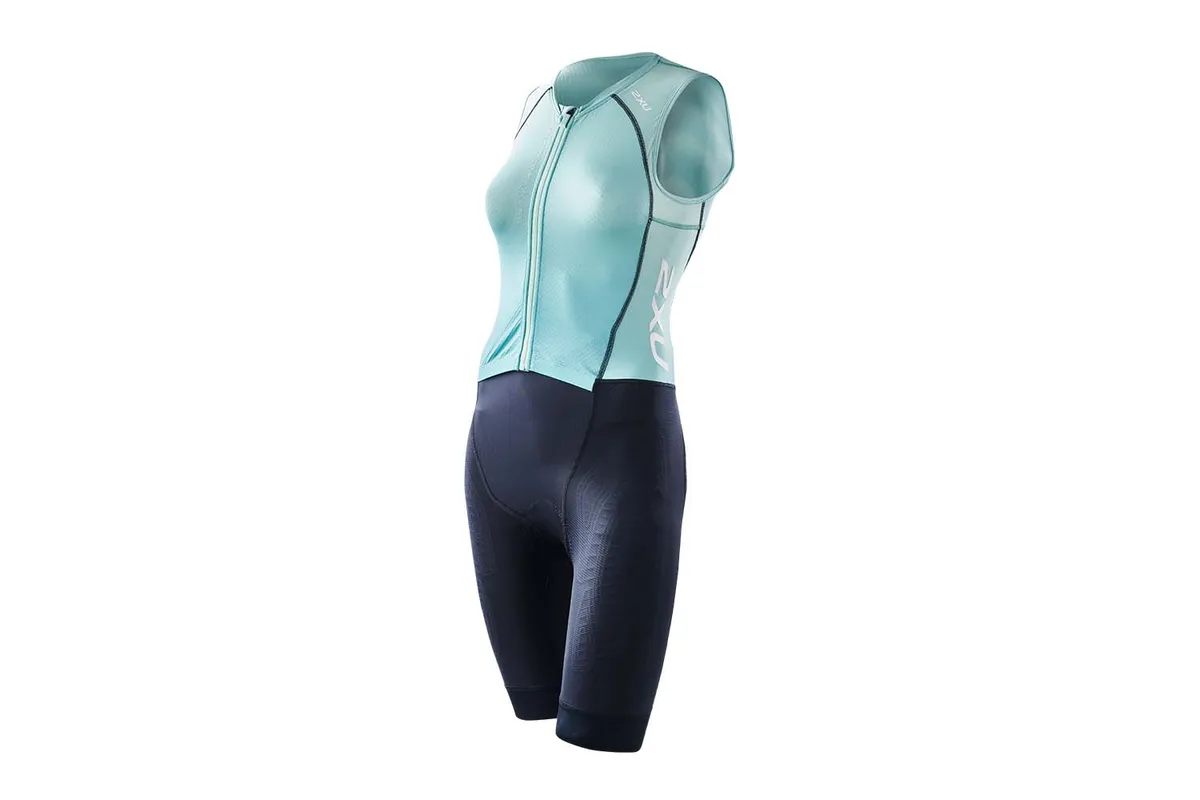
- £150 / $249.99
Bucking the long-sleeve trend, 2XU’s sleeveless tri-suit targets heat control and muscle stabilisation. The UV protective fabric claims to reduce heat absorption from the sun, improve airflow by almost 200% and provide enhanced aerodynamics.
In testing it felt lightweight and breathable, aided by the open-cut under arms and neckline, giving the feeling of freedom even during the hottest session.
Targeted compression claims to dissipate load transfer on the knee while running which, in practice, made our quads feel well-supported. The chamois felt stiff at first but proved comfy through all our cycling and gave us no issues on the run.
The two rear pockets were disappointingly small, though, and we found the split front design cut in on our stomach and pulled up when standing, so taller athletes may want to size up to accommodate this.
Verdict: Poor storage, but provides decent freedom and flexibility to get on with your race.
Score: 83%
Trimtex Aero 3.0
- Buy now from Trimtex (€359)
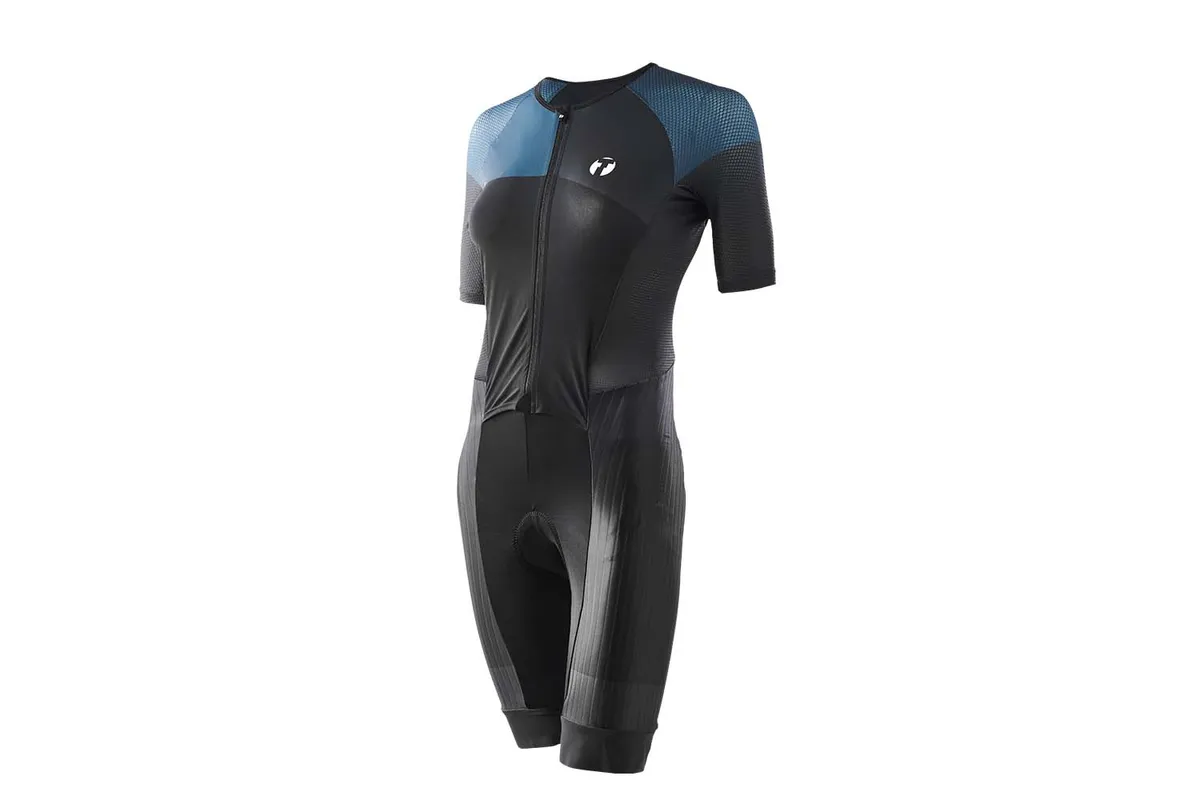
- €359
Kristian Blummenfelt wore the men’s version of the Aero 3.0 when he went 3:25:21 at 70.3 Bahrain in 2019, so we know they’re built for speed.
The women’s Aero 3.0 is bursting with aero enhancements tailored to each part of the body, such as the fabric which includes dimpled mesh around the arms and shoulders and ribbed panels on the legs.
There’s clearly no compromise on quality, with the quick-drying, breathable material offering flexibility and a specially adapted chamois providing multidiscipline comfort.
Wide leg grippers prevent unwanted movement and the split front design allows extra movement during the run and swim.
Two rear pockets are also deep enough to hold fuel for all-day racing. Trimtex advises it’s an extreme fit and to size up, but if anything our sample felt roomy, so ideally try before you buy.
Verdict: It's a hefty price tag but the suit oozes quality and may help shave off those precious seconds.
Score: 92%
Zone3 Lava Women's Short Sleeve Tri-Suit
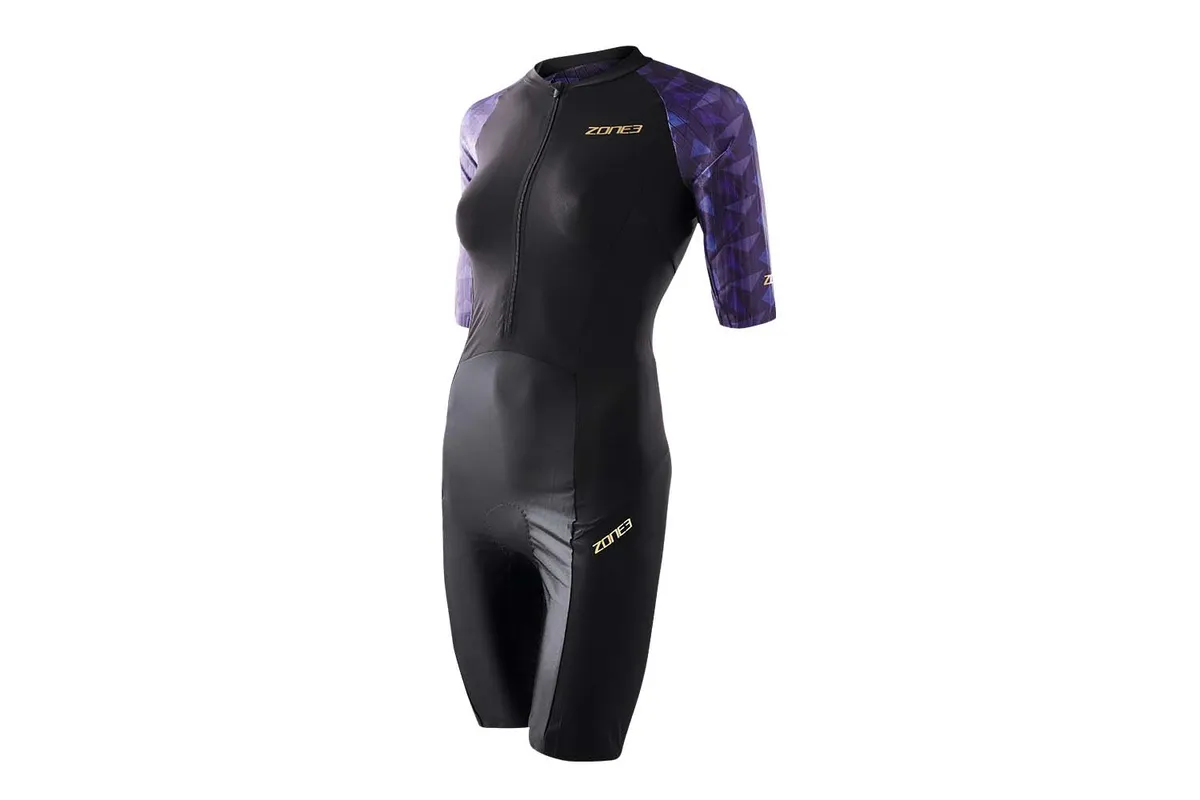
- £219 / $349
The Lava range has been around since 2013 and it’s easy to see why it’s been a hit. It not only looks stylish but packs in plenty of performance-enhancing features.
Drag-reducing Aero-Stripe arms offer enhanced aerodynamics, while the balanced compression in the legs provides muscle support to help improve endurance and stamina.
The Aeroforce Soft-Touch fabric gives a touch of luxury, with that barely-there feeling offering flexibility and breathability, all while providing 50 UPF protection.
Comfort is also taken care of with the women’s specific pad providing targeted pressure point relief on the bike while remaining unobtrusive during the swim and run.
A close fit and 360° stretch means no compromise in movement and plenty of freedom around the hips and waist. We could wear this all day.
Verdict: Ticks all the boxes, offering performance, comfort and style in abundance.
Score: 89%
Zoot Elite Tri Aero Racesuit
- Buy now from Zoot ($295)
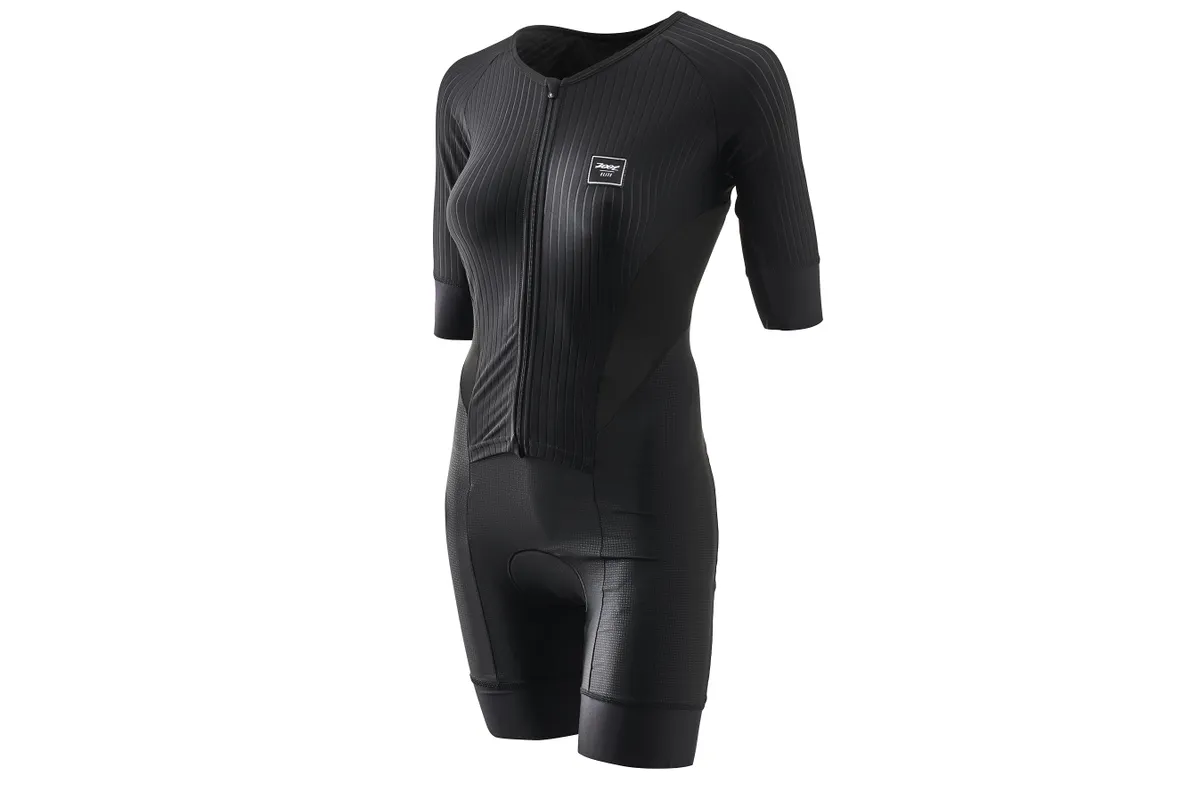
- £225 / $299.95
Part of Zoot’s new Elite range, this suit sets the standard in performance and comfort. The compressive fabric claims to increase circulation and muscular support.
In practice, the light and breathable fabric provides gentle core support while retaining complete flexibility. Taller athletes are accommodated with the split-suit design, and the ribbed ‘Highway Aero’ arms and chest panels reduce drag.
The chamois pad offers excellent shock absorption and particular comfort in the TT position. A trio of rear pockets delivers plentiful storage and easy access.
The premium Italian fabrics offer UV50 sun protection and, although we’d like a splash of colour, this is a tri-suit that performs on every level.
Verdict: A pricey affair no doubt, but, if you can afford it, this one is worth every penny.
Score: 91%
What types of tri-suit are there?
Tri-suit types now number short-sleeved versions, classic sleeveless options, two-piece tri-suits, tight speed suits, ITU-friendly suits with reverse zippers, and even thermal suits for races in colder climes.
Each sub-genre boasts (deep breath) various pad size options, different pocket types and placements, a number of material choices (a stretchy 20% elastane and 80% nylon mix dominates the suits on test here, but polyester is common on cheaper suits), compressive properties and more.
Male and female-specific suits will also be cut differently to conform to different body shapes, while the aesthetics can differ between genders (thankfully women can now buy suits without a splash of pink somewhere!).
Each type of tri-suit should perform in its chosen niche, but the versatility of short-sleeved suits at every triathlon distance ensures that’s mainly what we’re reviewing here.
With that all said, let’s take a look at the different types of tri-suits on the market…
The two-piece tri-suit
Two-piece tri-suits (made famous by pro athletes Kenny Souza and Faris Al-Sultan) are separate padded shorts and zipped top.
The benefits are that you can buy a different-sized top or bottom to secure your closest fit, while mid-race toilet stops are a doddle.
Negative points include an aerodynamic penalty from fabric bunching at the waist; they’re not ideal for the swim (you can swim in the shorts and don the top in T1); and the top can ride up/or the shorts sag down to reveal both belly and/or bottom to your race rivals (or watching family).
Improved hem tech has improved the latter, however, while they offer more versatility for training sessions than a conventional one-piece tri-suit does.
Vested (or sleeveless) tri-suits
Despite the growth of sleeved tri-suits, the classic vested tri-suit still has its place in triathlon, especially for shorter races.
The lack of arms ensures an unrestricted swim stroke and a lack of wet sleeves on the bike, while they can be better for athletes who struggle in the heat and a reduction in the amount of fabric can mean cheaper prices.
Downsides include a lack of UV protection from the sleeves and an aerodynamic (and, for us, an aesthetic) penalty.
The ITU style triathlon suit
Suits without a front zip are often called ITU-style suits, and they feature a rear zipper on men’s styles and either a swim-suit-style back or rear zipper on women’s.
The advantages are increased hydrodynamics for non-wetsuit swims (making them ideal for pool triathlons) and comfort, with no chances of the zip rubbing on chests.
Disadvantages include a lack of practicality for toilet stops and difficulty lowering the zip for cooling (if the race rules allow it).
The short-sleeved tri-suit
Short-sleeved tri-suits were only truly established around a decade ago, but they’ve since experienced a surge in popularity and tech advancements.
They should offer improved aerodynamics if the fit is precise, better looks (especially if you don’t have Popeye-esque biceps) and protection from UV rays.
The key is ensuring the sleeves don’t inhibit your swim stroke, the seams don’t rub under the arms and you don’t suffer from overheating on the arms.
Sleeved vs vested tri-suits
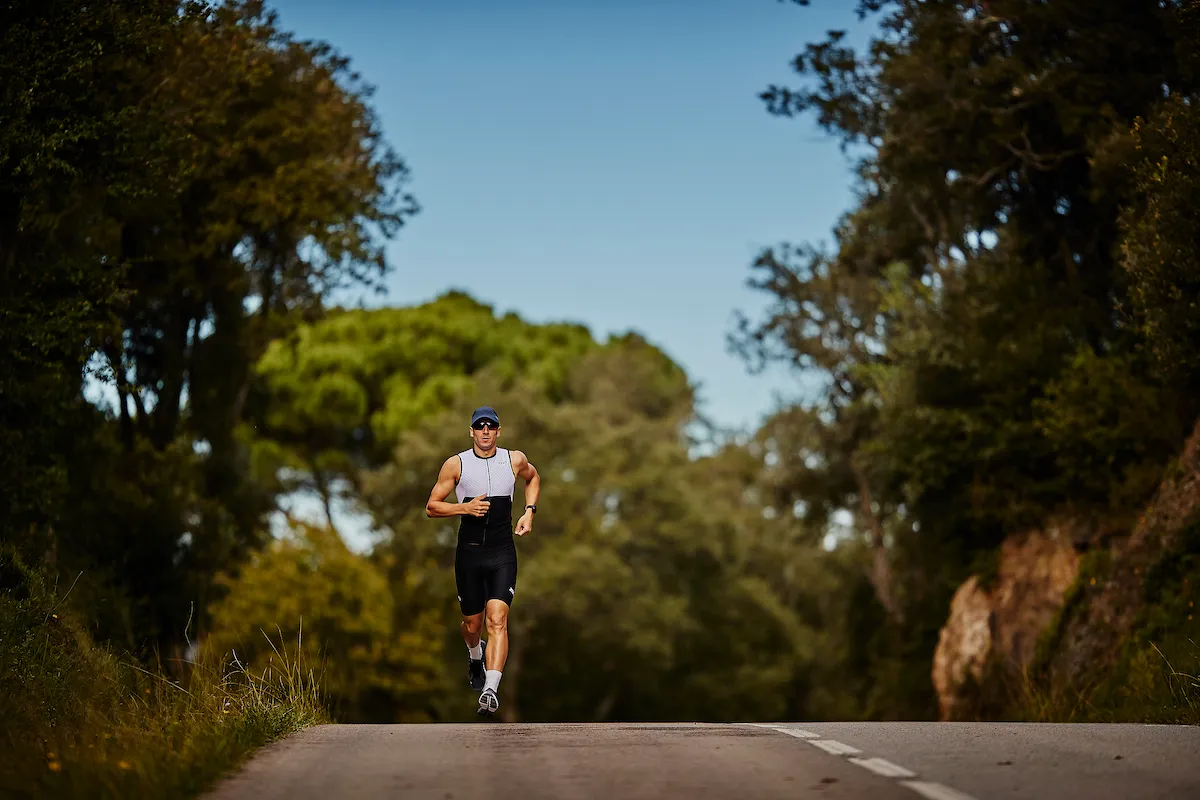
The last decade has seen the rise of the short-sleeved tri-suit, and they now largely dominate tri courses of every distance.
There are still merits to vests, however, including unrestricted upper-body movement on the swim, no damp sleeves on the bike and a cheaper initial outlay.
The benefits of short-sleeve suits are plentiful, though, including increased hydro and aerodynamics (fabric is faster than bare skin), more sun protection, added warmth and, well, they just tend to look better for many of us (especially if you don’t have arms like The Rock).
The advent of sleeved triathlon suits also saw the rise of full-length zippers, which open up at the bottom.
This makes pre/mid-race toilet stops far easier, but remember that race rules dictate that you shouldn’t lower your zip further than the bottom of the breastbone when on a middle/long-distance course, and must be completely done up on sprint and standard events.
How much time can a good tri-suit save?
Our own wind-tunnel testing has also shown the importance of a well-fitted suit, with the likes of taped seams, dimpled or pinstripe fabric and lengthy arms and legs saving triathletes 60secs over a 40km Olympic-distance bike leg (over 4mins in Ironman).
A key stat to note when contemplating aero changes is that around 70-80% of aerodynamic drag is caused by the rider, with just 20-30% coming from the bike, so size carefully and you’ll soon be reaping the aero goods.
Potential pitfalls when choosing a tri-suit

You’ll be spending plenty of time racing in your chosen suit and something that bugs you on a 60-minute brick set will become a full-blown issue on race day.
If you can get your hands on the suit before buying it, look out for any rogue internal seams.
Also assess whether the suit has a decent zip guard to stop it rubbing on the top of your chest or lower neck.
Vented fabrics are great at giving a cooling effect on race day, but can offer minimal sun protection, especially if the swim leg has erased your suncream.
Also, check whether the fabric is see-through on the chest or rear – a suit wet from the swim can leave little to the imagination.
Can and should I get a cheap tri-suit?
There will inevitably be compromises when buying a cheap sub-£50 tri-suit, but there are plenty out there that punch above their fiscal weight.
The finishing quality can be lacking a touch, the polyester can be slower to dry than suits made with elastane and any hints of aerodynamics are limited.
But you might get some decent grippers trickling down from higher-priced suits, a solid chamois for shorter sprint and Olympic-distance bike legs, and a pocket or two for stashing an energy gel or bar.
Go longer than the 1.5km swim/40km bike/10km run of Olympic-distance tri, however, and we’d recommend spending more than around the £75 mark.
Wiggle and Decathlon are good places to start for a budget triathlon suit, but also keep an eye out for sample sales from brands.